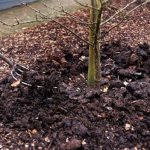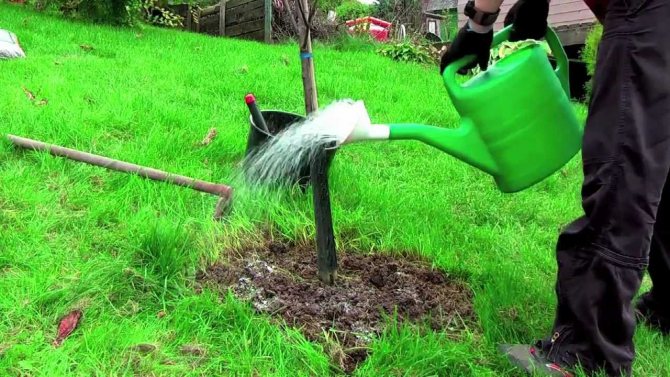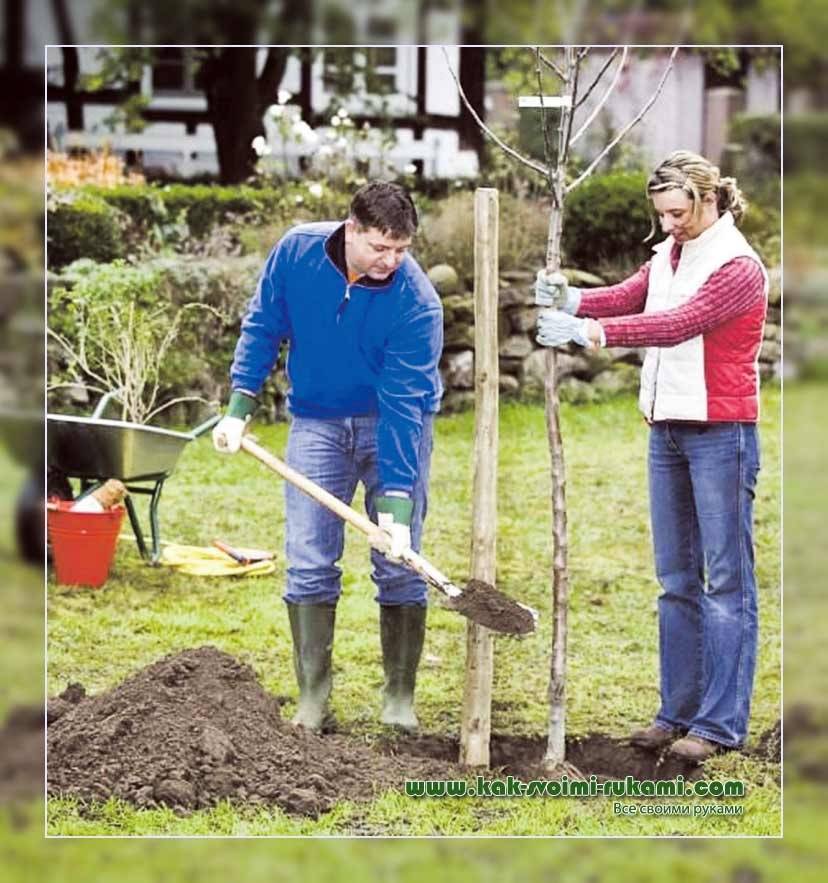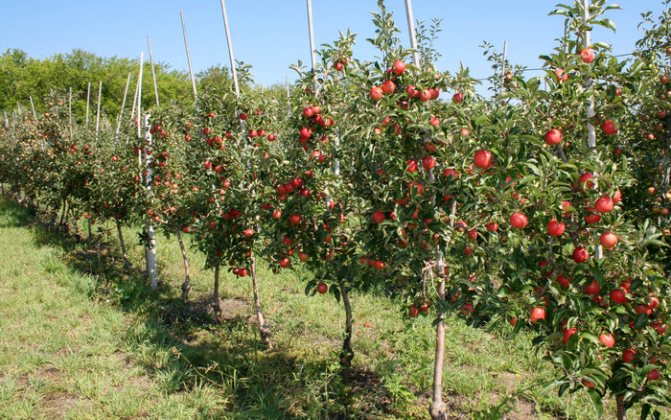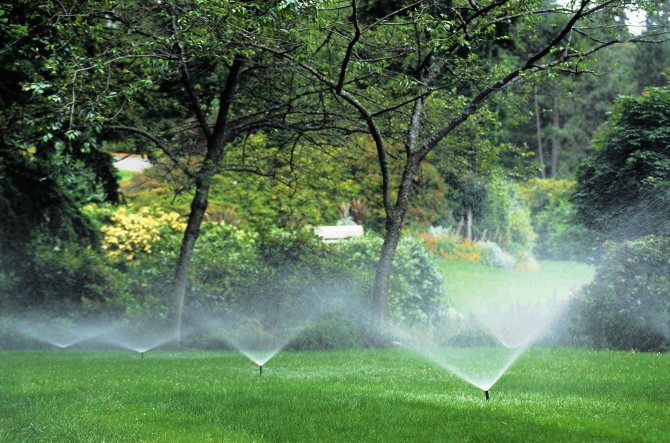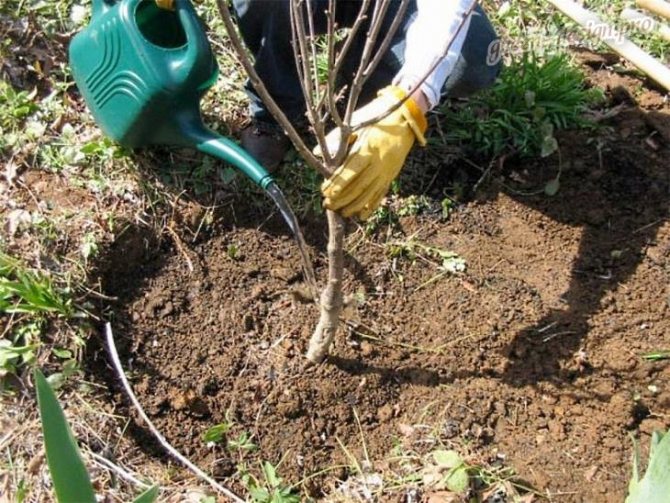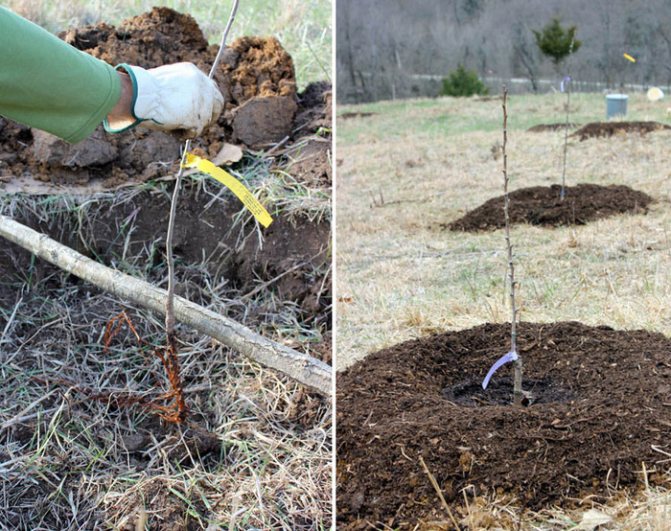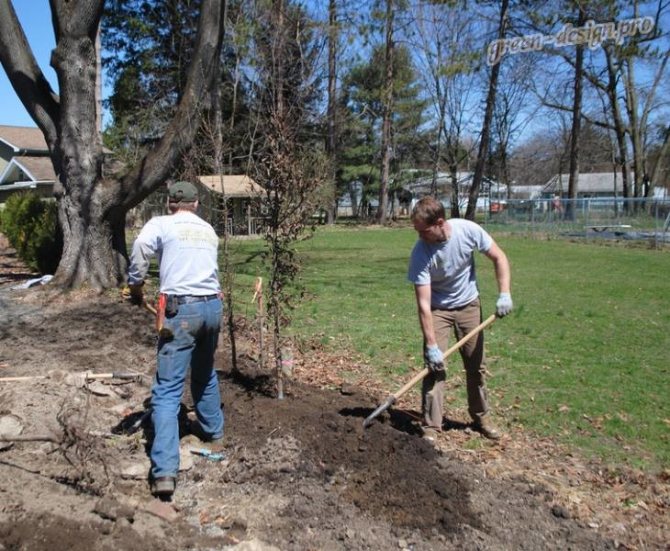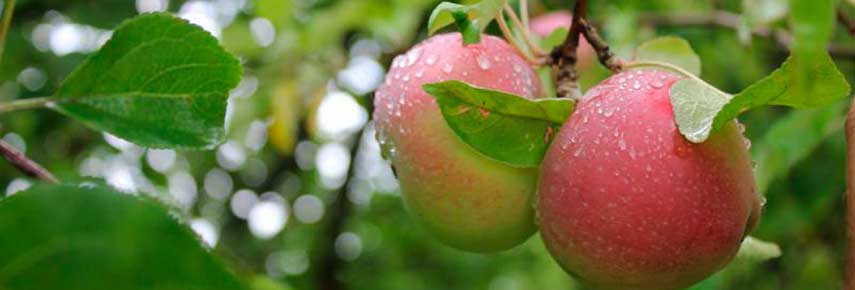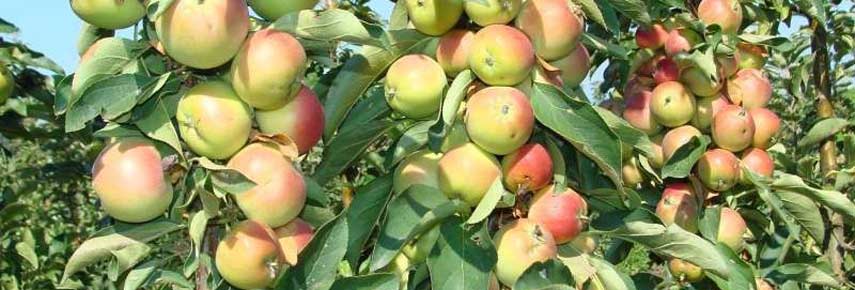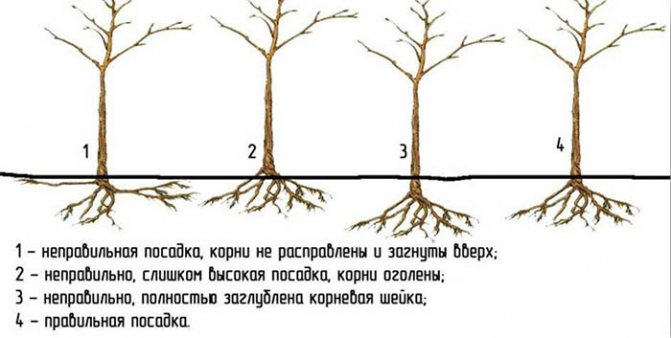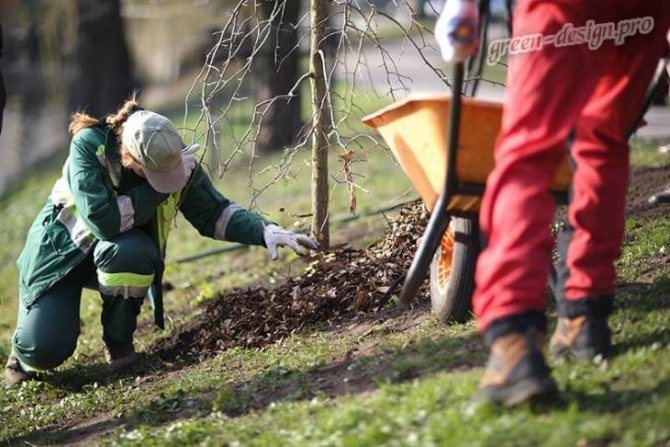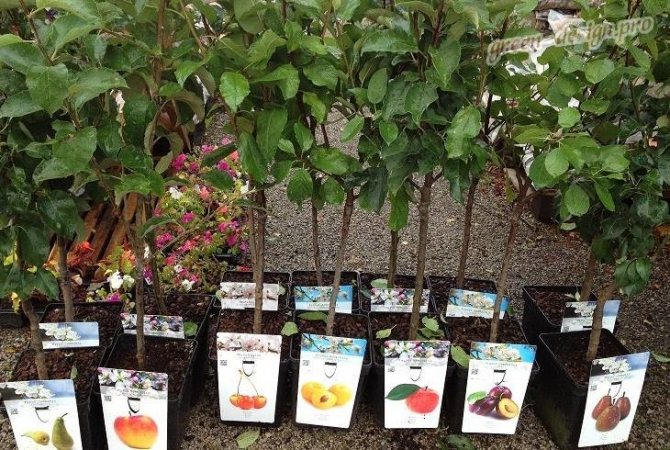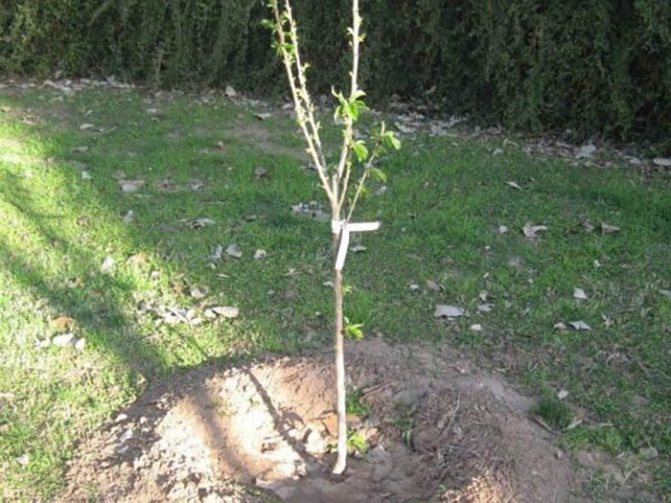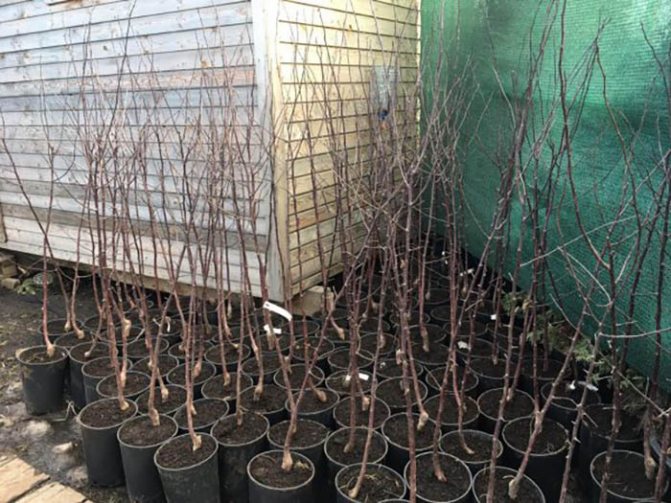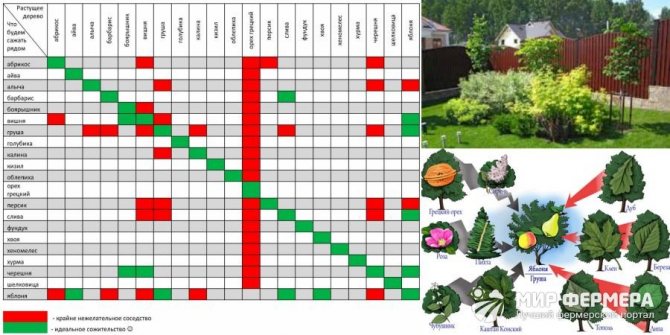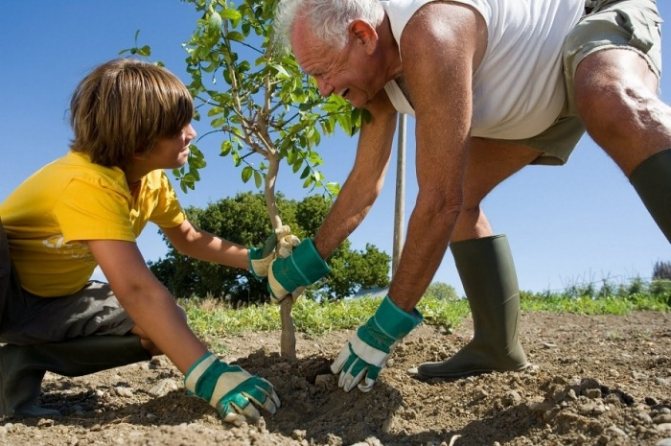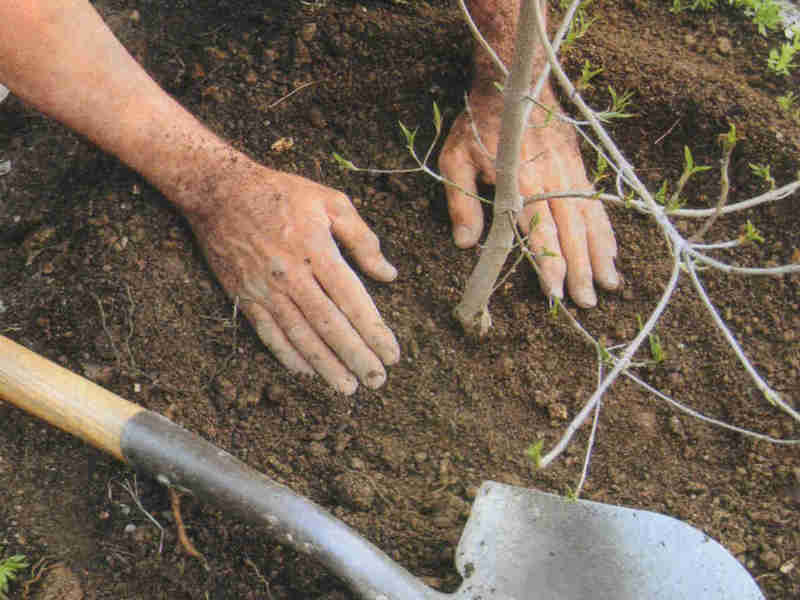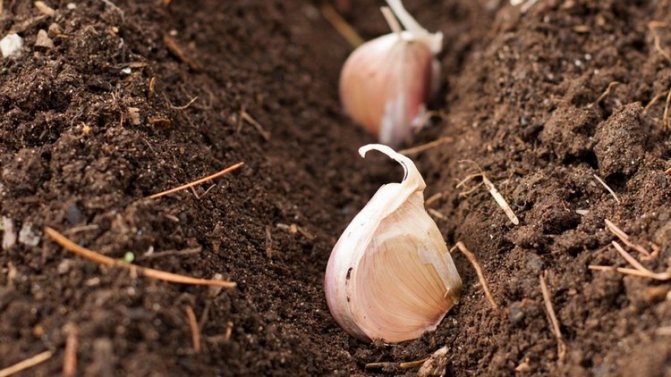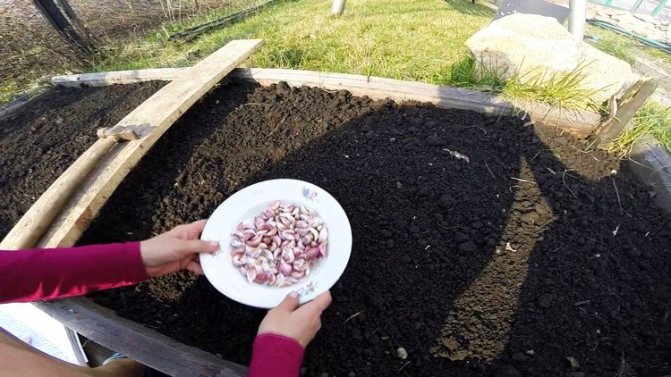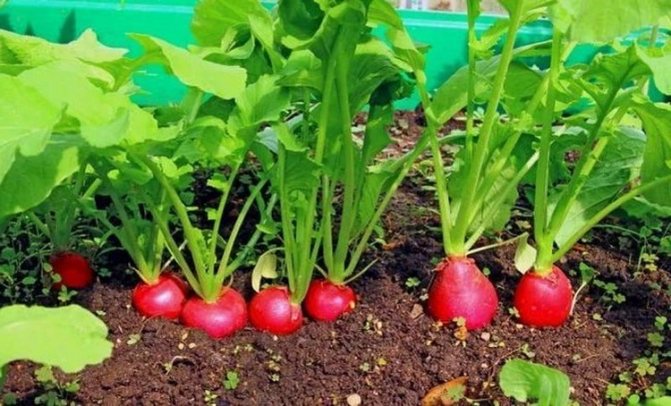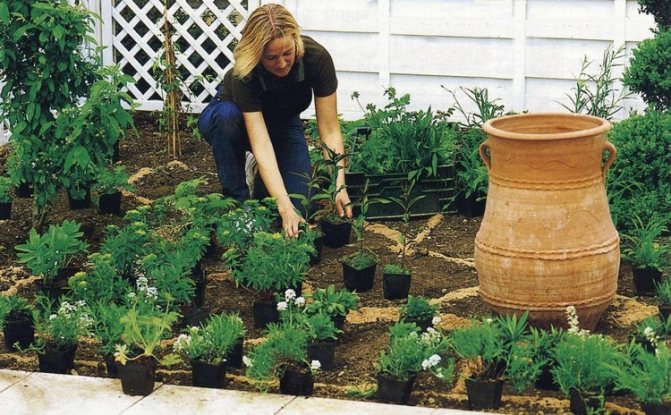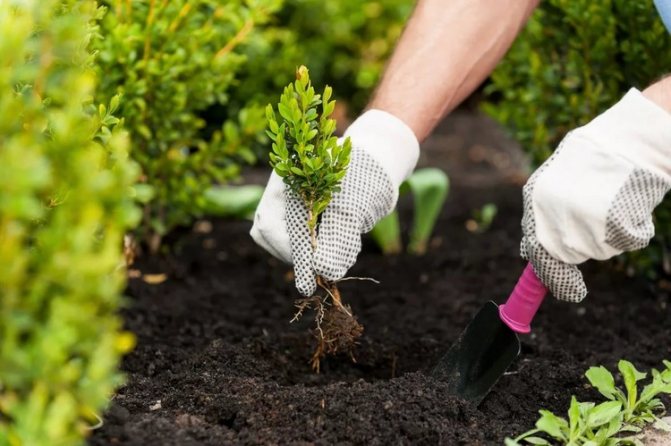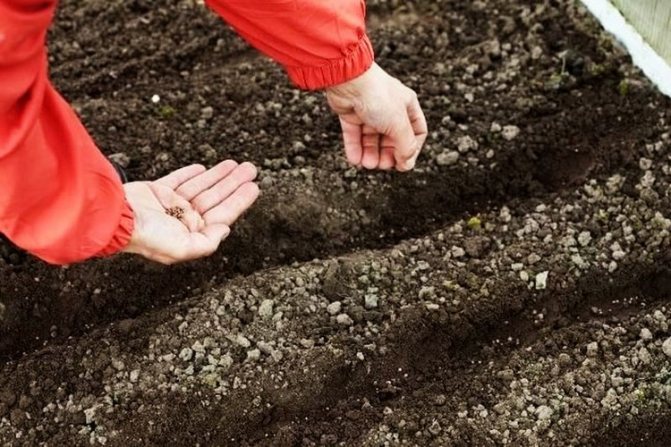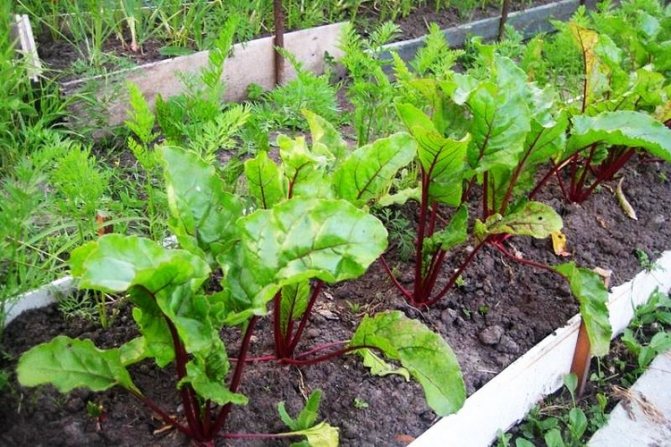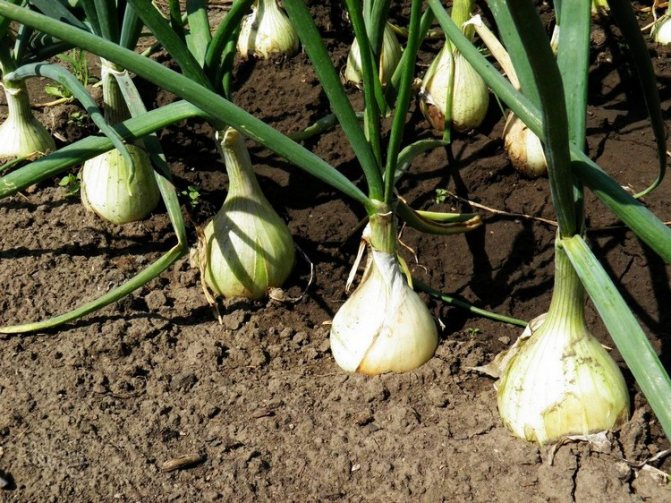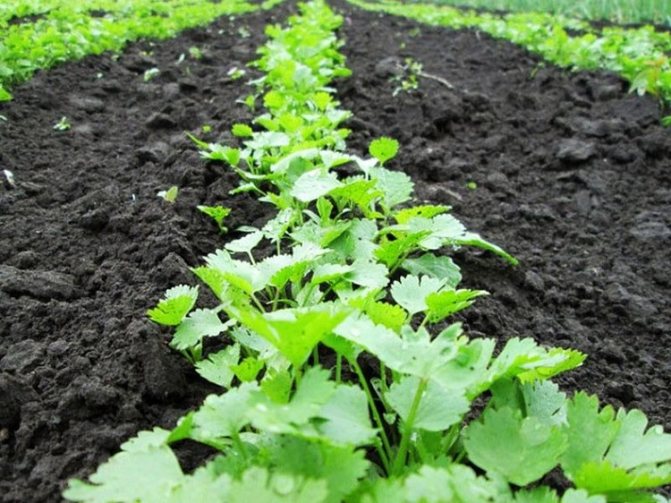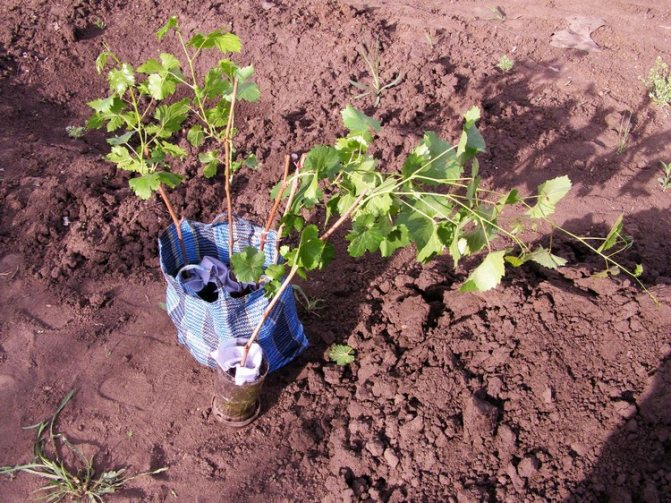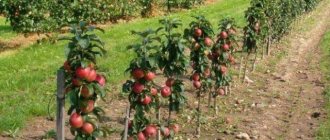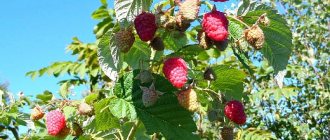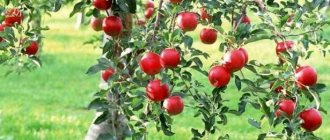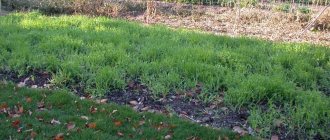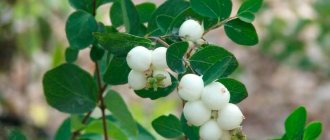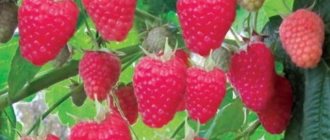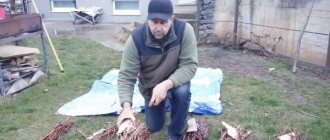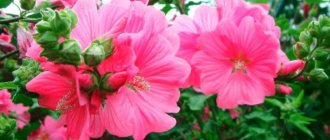Now it's time to buy seedlings again. Unfortunately, many gardeners do this important work in a hurry and even spontaneously. I walked past the market - I saw - I bought it. But you plant the plant in the garden for many, many years. Moreover, you want it to look good, and in the case of fruit crops, it also gives a good harvest, at the same time - every year. Responsible, I would say, work. In this article, we will look at the main points to consider when choosing tree seedlings for planting in the fall.
Can apple trees be planted in autumn?
The first question that arises for beginners: "How and when to plant apple trees in the fall?" It is not devoid of logic, because soon it will be cold, and winters in our latitudes are too harsh.
But, oddly enough, to do planting an apple tree is advised in the fall... However, one should not forget about the peculiarities of each individual region.
In the regions of the Non-Black Earth Region it is better to choose the early spring months, for the Ukrainian regions the period of late summer - early autumn will be ideal, and the Ural, Siberian and Belarusian gardeners are trying to complete this business as early as possible.
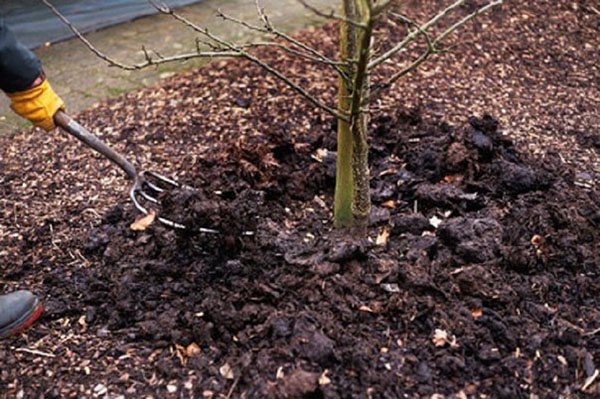
Planting an apple tree in the fall is considered the optimal time.
Why is autumn considered the right time?
This time of the year is quite humid. The rainy season usually lasts until mid-November. At the same time, the air temperature is high enough to start planting a tree.
IMPORTANT! It is necessary to plant an apple tree at least a month before the onset of frost, when the foliage has already completely fallen out.
Even a slight minus temperature negatively affects the development of the plant's root system.
The fact is that before the onset of winter, trees hibernate, all biological processes in them slow down. In this state, the seedlings are better able to tolerate digging and "relocation" to a new place.
It is imperative to give a young tree time for adaptation in new conditions before frost hits.
The most important advantage of autumn planting is that the tree will have time to "settle" in the soil, its root system will get stronger, and in the spring the apple tree will already begin to develop actively.
How and when to plant berry bushes
Planting seedlings in spring is no different from planting in autumn. Shrubs require smaller pits, but fertilizer must be applied to the ground just like under trees. The planting technique usually involves order plantings. The gap should be at least a meter between rows and at least half a meter apart in a row.
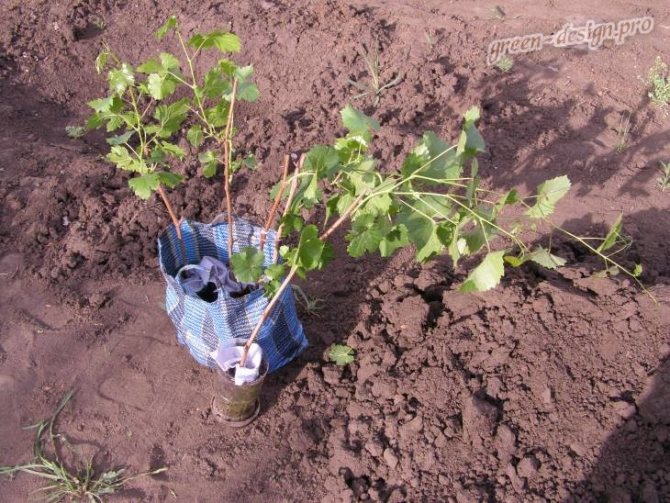

Thawed ground and night temperatures above zero signal the beginning of the shrub planting period. Mid-April is considered optimal in our latitudes. But you can also land on May days. At the same time, it is recommended to moisturize such bushes more intensively during the warm season.
Planting trees and shrubs in spring will allow you to get a big harvest and beautifully growing healthy plantings that please the eye.
Site preparation
Planting any tree begins with preparing a suitable place... It is worth taking care of the area for the apple tree in advance, no later than two to three months (it is best to do this in the spring). The ideal area will be the area where fruit trees have not grown before.
The depth of the pit is of particular importance for the apple tree..
If the planting site is too deep, then the air will no longer flow to the root system in sufficient quantities. In this case, the roots may even start to rot.
A shallow hole will also bring only problems: exposed roots will begin to deteriorate due to exposure to low temperatures.
Watch a video about preparing a place for planting an apple tree:
To form the pit correctly, follow these rules in the sequence below:
- Caution remove the sod, then the topsoil is the most fertile. Fold them separately.
- Remove the next 20-30 cm of soil.
- Dig up everything and carefully align.
- The depth of the resulting hole should be approximately half a meter, and the width should not be more than a meter.
- Place the turf on the bottom (grass side down). This is necessary so that the grass, microorganisms and other "population" of this layer rotted and turned into humus, thereby increasing the quality and quantity of nutrients for the young tree.
- Prepare wood ash, leaf compost, stale cow dung in advance (it can be replaced with horse manure, but in no case with bird droppings). Mix these ingredients well. They must be placed in the pit, continuing to mix thoroughly to ensure sufficient looseness and moisture.
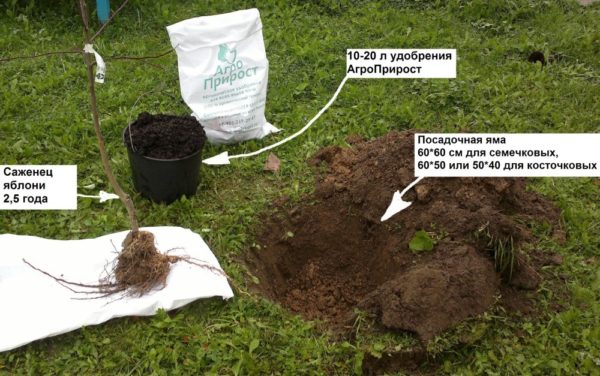

Planting an apple tree in a prepared place. - Be sure to put a mark so that after a while you can find a prepared place. Be attentive to the peculiarities of the soil. If it has a clay texture, do not dig too deep a hole. Maximum - 30 cm. But make it wide enough (up to 1.5 meters). So nothing will prevent the root system from growing in breadth.
- Be sure to provide a normal flow of air and moisture into the pit. To do this, you need to replace the clay with sand and humus.
IMPORTANT! It is advisable to avoid clay, loamy and sandy soil for planting.
The occurrence of groundwater is also important.... Ideal would be the conditions in which groundwater will lie no closer than 2.5 meters.
If unfavorable conditions cannot be avoided on the site, it is better to plant a tree on a small mound, the height of which will be about half a meter, and the width - about a meter.
These mounds are made from turf and topsoil.
Choosing a landing site
Choose a place for planting seedlings seriously in the fall - after all, this is for several decades. Not a single fruit tree or berry shrub will thrive in the shade. Consider how your trees will grow over time, whether they will create shade for the entire area. If your garden is in a lowland, where groundwater rises high enough in the spring, it is better not to dig planting holes, but to plant plants on mounds without burying the roots. If it turns out that the roots of the plant will be flooded for some time, it may not die, but it will not bear fruit, because it will spend all its strength on the annual regrowth of the roots that died during flooding.
Sapling selection
The main criterion for choosing a seedling is its health... Buying a young plant from an unverified person is a big risk. A suitable place to buy is a special nursery.
It is best to choose a plant for planting no older than two years. Before the purchase ask experienced gardeners which varieties do best in this climate... Give them preference.
Pay special attention to the roots... They must be free of signs of damage, mold or mildew. A healthy tree usually has many roots. They are usually of different lengths. This is a normal feature.
If you think the roots are too long, don't worry, they can be trimmed slightly.
Smooth (this means, without any suspicious damage) the bark should be dark brown - this is the natural color... The crown of a young tree should already consist of more than 4 branches. The graft should be located approximately 5 cm from the root.
Doubtful PLACE OF PURCHASE OF SEEDLING
How many articles have been written on this topic, but summer residents continue to step on the same rake. Do not buy seedlings on the way! Even if they are half the price there. There is a great risk that you will be sold, at best, a plant of a different variety or of a different breed than you ask for, at worst - an unzoned variety or a diseased plant, which can also become a breeding ground for diseases and pests in the garden.
In autumn, it is important to finish planting seedlings no later than 20 days before the soil freezes.
Do not be lazy to visit a nursery with a good reputation in your area, where they will offer a wide range of seedlings, perhaps they will even dig out with you, give qualified advice on planting and caring for the plant.
For planting, it is better to choose annual seedlings - they take root well. Biennial plants are also suitable.
Correct planting of an apple tree in autumn
Before proceeding directly to planting, the tree must be placed in water for a day. This is necessary to avoid root drying... Take a close look at the bark of the apple tree.
The place where the color of the bark is slightly darker than in other places is the root collar, which should be slightly higher in the ground level than the rhizome.
When they plant an apple tree the neck must be covered with earth a little. However, over time, the soil subsides and this place is exposed.
It is impossible to cover the vaccination site with earth.... It should be raised at least 5-9 cm. It is prohibited to tamp the ground during planting, because this will interfere with the free access of oxygen to the root.
Immediately after planting, you need to tie the tree to the pegs.... Their number depends on climatic conditions. The main thing is to ensure the safety of the young tree and protect it from breakage.
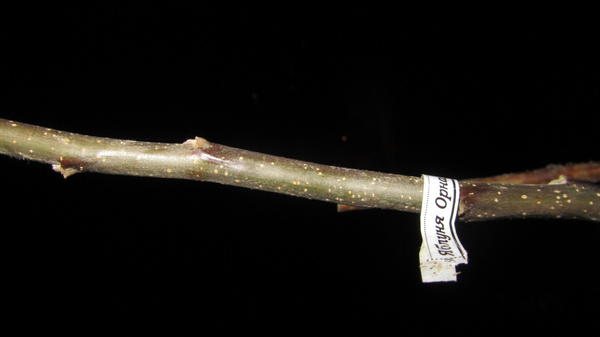

Pay attention to the color of the bark of the seedling.
For this you need to use either wet rags or films so as not to harm the bark. Even in rainy weather, the seedling needs to be watered after planting.
IMPORTANT! 4 meters is the ideal distance the apple tree should be from other fruit trees.
Planting trees in autumn
... At the same time, the bark can shrivel, the resistance of plants decreases. Frost can damage the ground part of a tree or shrub. And sometimes in trouble when it freezes
, it is not so much the frost and winter that are to blame, but the dry autumn and the careless owner.
In order to prepare the garden for a safe wintering, you need to carry out water-charging watering. It differs from the usual summer ones in that it requires much larger volumes of water.
Sufficiently moistened soil has a higher thermal conductivity and allows heat from the lower horizons to warm up the plant roots more freely. But here it is important not to overdo it. If the soil is waterlogged, flooded, then the water will simply displace the air from its pores, and this can cause the roots to die off - they will begin to suffocate.
Fertilization allows the apple tree to accumulate a large vegetative mass, which in the future will allow it to grow many tasty fruits. To do this, in the first 2 years, feeding is done in early spring.
The first top dressing is made with mullein infusion, and in May and June one foliar top dressing is done with a complex fertilizer with microelements ("Zdraven-Turbo", "Agrovita for fruit trees", "Alliance for fruit trees").
For root feeding of apple trees with nitrogen in the spring, it is necessary to pour and level a bucket of compost or humus into the trunk circle.
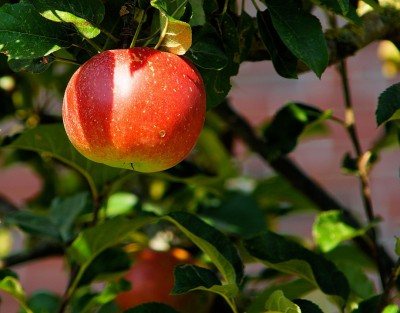

In the following years, before the beginning of fruiting of apple trees, in addition to spring feeding with humus with the simultaneous mulching of the trunk circle (12-18 kg per tree), in the fall they do fertilizing with phosphorus-potassium mineral salts, for digging or hoeing:
- For southern gardens - potassium sulfate 25-35g, double superphosphate 25-35g; ash from a fire or wood ash 150 grams;
- For non-black earth - double superphosphate 35-45g, potassium sulfate 35-50 grams, ash or ash 250 grams.
TIP: Don't overfeed your trees with fertilizers, especially nitrogen. This has a bad effect on the overwintering of apple trees and the keeping quality of apples. It would be better to supplement the nutrition with a subcortex “on the leaf” with a complex fertilizer (as indicated above) or a missing element.
It is also customary to feed apple trees that have just entered fruiting with urea, and in years with poor flowering this can be done after.
For this, 35 grams of urea is dissolved in 10 liters of water and the tree is treated with a sprayer.
The first treatment - as soon as the flower petals of the apple trees crumbled, the second - after a month, and the third - when the fruits are poured. The last time the dose can be increased to 55 grams, if the weather is cool and damp summers.
In all types of young apple orchards, not only the trunks are whitened, but also the branches that form the base of the tree.
The most suitable period for whitewashing will be from February 21 to March 31. And the further south the garden is located, the earlier it is whitewashed. This will protect the young uncoarse bark of apple trees from "sunburn" and from frost damage caused by a sharp change in temperature.
For whitewashing itself, you can use carbide, quicklime and fluff lime.
VERY IMPORTANT! Under no circumstances use bleach and compositions that are ready for work in damp rooms !!! This is dangerous for apple trees!
Whitewashing recipe: In 8 liters of water poured into a 10 liter plastic bucket, dissolve 2 kg of fluff, 1 kg of fatty clay, 1 glass of skim milk, 10 grams of carpentry glue or 30 grams of office glue, or one loaf of fresh mullein.
Having prepared a whitewash without glue, you will need to whitewash the entire garden after the first serious rain!
Late whitewashing of apple trees before the holidays in May will only decorate the garden, not really helping the apple trees. As well as whitewashing very old bark of trees that are over 20 years old.
They whitewash with maklovitsa, trying to carefully coat everything. With a large number of apple trees, whitewashing is mechanized.
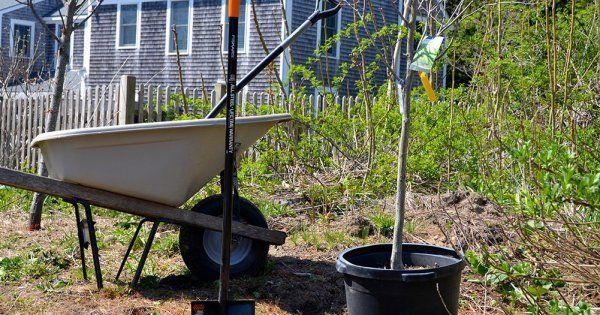

If for some reason whitewashing is not possible, then tying branches and trunks of apple trees with old agrofibre, matting, sheaves of corn badylka (corn shoots left in the field for the winter) or spruce branches will also help apple trees not "burn" in the sun.
Read more about whitewashing apple tree trunks here.
Chemical, biological protection against diseases and various harmful insects is one of the three important components in the question of how to care for a young apple tree.
Chemical protection of the garden should be carried out only as a destructive measure and in no case should be used "for the sake of prevention."
Because “chemistry” is equally dangerous for both harmful and beneficial insects, but harmful ones, getting used to the poison, multiply to incredible volumes, while beneficial insects recover much more slowly.
How to plant with a closed root system?
A closed-root apple tree is a seedling bought directly in a pot or container. Such a plant requires a special attitude towards itself.
What are the rules for planting an apple tree in the fall in this case?
- Need to prepare the pit (you need to follow the rules above). Its size should not exceed half a meter in depth and a meter in width.
- The bottom layer, which is not fertile, must be removed... Instead, fill the hole with topsoil, ash and fertilizers (optional).
- In this hole, you need to make a hole the size of a pot or container.
- Turn the pot upside down. Carefully, while holding the seedling together with the earth, remove the container. To make it easier, water the plant first. This will minimize the risk of root trauma.
- Place the seedling together with the ground in the hole so that the level of the soil from the pot coincides with the level of the soil in the pit or rises slightly above it. It is impossible to fill up the soil from the pot, so as not to displace the correct position of the root collar.
- Place a peg next to the pit to tie up the sapling.
- Fill the space between the hole and the soil from the pot with soil, watering abundantly.
- Lightly tamp the ground around the perimeter of the hole with your feet (this must be done very carefully, the toe should look at the seedling itself).
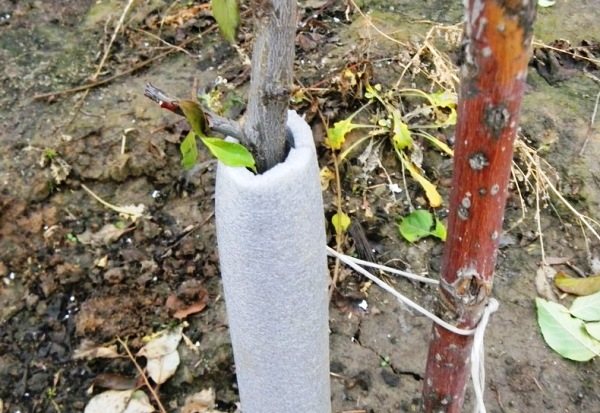

Tie the seedling to a peg.
Seedling care
The apple tree needs a couple of weeks to root. At this time, water it only under the condition of dry warm autumn, but not earlier than a week after planting. It is more important to prepare the tree for the first wintering:
- with the threat of frost, fallen leaves and peat are poured around the trunk;
- by the onset of stable average daily temperatures below zero, spruce branches are laid around the trunk for snow retention, protection from rodents;
- scraps of rubber hoses and car cameras are scattered in the near-trunk circle - the smell will scare off mice that like the tender bark of young trees.
Important! In the spring, with the first thaws, the shelter is removed, the mulch is moved away from the bark so that it does not mace. The stem is whitewashed against sunburn.
Fertilizer question
When planting an apple tree in the fall, it is useless to use a large amount of nitrogen fertilizers. They are best applied in the spring when you need to stimulate plant growth.
Fresh manure (horse or cow) should be applied to the very bottom of the planting pit and separated from the root system with a layer of soil. But it is best to use already rotted manure in combination with compost, ash and sand.
IMPORTANT! Fresh manure should not be abused when planting young trees. Once in the ground, it releases ammonia and hydrogen sulfide, thereby poisoning the rhizome.
Of the mineral fertilizers, it is best to stop at phosphorus and potash.
Convenient also buy fertilizers with the name "Autumn"... They usually contain sufficient amounts of phosphorus, potassium and a small proportion of nitrogen.
Highly it is important to reduce soil acidity during autumn planting... This is facilitated by the introduction of dolomite flour, slaked lime, and meadow marl into the soil.
It is impossible to use these substances together with phosphorus, because they make it difficult to dissolve.
If you are planning to set up a garden on a new plot of infertile soil, start fertilize the soil at least one year before planting trees... It is best to start domestication in 2-3 years.
When to remove shelter from apple trees in spring?
For autumn planting, it is best to choose plants that are zoned in your region. So what trees can you safely plant in the fall? In the conditions of the middle zone and the Urals, pear, apple, cherry, cherry plum, mountain ash, mulberry, as well as varieties of plums of Siberian and Ural selection, are best tolerated this season.
But with planting apricots, peaches, cherries, almonds, it is better to wait until spring. Autumn planting of seedlings of these plants is possible only in the southern regions, but also does not guarantee high survival rate.
The timing of planting fruit trees also varies depending on the region. In the northern regions, the best time for planting is September - early October. In the middle lane, fruit trees can be planted from September to mid-October. And in the southern regions, gardeners are in no hurry and are engaged in planting work until mid-November.
Can you plant trees if you are a little late? Unfortunately no. It is better to dig such seedlings before spring.
Most plants develop and bear fruit better on the southern side of the site with low groundwater levels. And fruit trees are no exception. If the size and landscape of your site does not allow you to set up a huge garden on the sunny side, and you are faced with a difficult choice, just keep in mind that apricots, peaches and cherries will not give a decent harvest in low light. Pear, apple and plum are also quite light-requiring.
Experienced gardeners are tricky and plant plants in stages: tall ones - to the north, low-growing ones - to the south. This way all green pets get enough light.
When choosing a planting site for a tree, it is important to know in advance the approximate size of its future crown and root system. One of the most important points to consider when planting trees is the distance to the house and communications. On average, it is not recommended to plant fruit trees closer than 4.5 meters from communications, so that in the future you do not have to find funds for repairs.
- Planting trees and bushes - safety rules
Planting trees and shrubs - only at first glance - is a simple matter. There are safety regulations for this process as well. After all, you need not only to choose a seedling, to determine the depth of the planting pit and the fertilizers to be applied, but also to take into account some of the nuances that in the future can cause minor troubles or serious problems.
It is also extremely important to consider the compatibility of your green pets. After all, some plants can be good friends, while others are capable of oppressing each other, depriving sunlight or even releasing chemical compounds that will inhibit the development of other trees.
- An apricot will not feel very comfortable next to a cherry.
- It is undesirable to plant an apple tree next to a peach and cherry plum.
- Walnut oppresses the vast majority of fruit crops.
- How to properly plant trees in the garden
What can be difficult in planting a garden? At first glance, nothing. However, if the rules are not followed, trees will grow and bear fruit poorly.
The size of the planting pit depends on the root system of the plant. As a rule, for stone fruit it is worth preparing a hole with a diameter of 40 cm and a depth of about 60 cm.For pome tree species, the depth of the planting hole should be about 80 cm, and the diameter should be 60-80 cm. , the size of the planting pit will have to be increased, otherwise the roots will bend inward, and the tree will develop worse and hurt more often.
It is advisable to remove the top fertile soil layer carefully, without mixing with the rest of the earth. In the future, organic or mineral fertilizers are added to it.
It is recommended to make the bottom of the planting pit well-drained. To do this, you can pour crushed stone with a fraction of 20-40 mm, river pebbles or sand and gravel mixture.
Before planting, the seedling must be carefully inspected, cut off the soaked, dry, rotten, frozen and moldy ends of the roots. It is important not to get carried away. The size of the root system must match or exceed the size of the crown.
If the roots are very dry, the tree should be dipped in a bucket of water for a day.
At the bottom of the planting pit, it is advisable to install a peg, which will serve as a support for a young tree.
The roots of the seedling must be straightened and covered with nutritious soil mixture. For its preparation, fertile soil is mixed in equal proportions with rotted manure or compost (up to 30 kg per pit). Do not use fresh manure, as it can burn the roots of plants. If your site has clay soil, 3-5 buckets of coarse sand can be added to the nutrient substrate, and if it is sandy, then the same amount of clay.
In order to increase the amount of humus over time, the bottom of the pit can be expelled with turf, grass turned upside down.
If, before planting an apple tree, it is required to improve the quality of clay soil, the planting hole can be filled with a mixture of 2-3 buckets of peat, 3-4 buckets of humus, compost or black soil, 2-3 buckets of river sand, 2-3 glasses of sifted ash and 1 glass of superphosphate.
- 5 main rules for planting an apple tree on clay soil
We will tell you how to avoid mistakes when planting apple trees on clay soil.
When planting, the root collar of a fruit tree must be above ground level.Moreover, for different plants, a different degree of deepening is recommended. So for apple trees, pears, plums, cherry plums, peaches and apricots, the root collar should be 5-6 cm higher than the ground, for cherries and cherries - by 4-5 cm.
- 7 common mistakes when planting seedlings in autumn
In order for a seedling of a fruit tree or shrub planted in the fall to take root in a new place, try not to make mistakes when planting.
In order not to be mistaken and to plant the seedling correctly, gardeners use any improvised stick that is placed across the hole and the required distance is measured from it on the seedling trunk.
The roots are covered with a soil mixture 10-15 cm thick and watered with 2-3 buckets of water. Then the hole is filled with soil to the end without additional moisture.
In the fall, the land is humid enough as a result of the rains, so frequent watering will be a mistake. In general, the frequency of watering depends on weather conditions and soil conditions. There is only one indisputable rule: when watering seedlings after planting, moisture should reach the root system of the tree, therefore it is better to water the seedlings less often, but more abundantly. In rainy, damp years, some gardeners get by with just one autumn watering of seedlings directly at planting.
- How to water fruit trees in autumn - the secrets of water-charging watering
To water or not to water? And if so, how? We understand the intricacies of watering the garden in the fall.
In order to protect the roots of a young tree from frost and slow down the evaporation of moisture, it is advisable to mulch the soil around it with compost, fallen leaves, sawdust or freshly cut grass.
Some gardeners are in a hurry to whitewash the trunks and skeletal branches of the seedlings. However, experts do not recommend whitening plants with smooth bark, because this clogs pores, slows down gas exchange and sometimes causes bark burns. It is best to postpone this procedure until fruiting begins.
If you still have questions about planting seedlings of fruit trees, pay attention to the advice of the candidate of biological sciences Raisa Matveeva.
The apple tree is planted so that the root collar is 2-4 cm above the soil surface and is covered with a soil mound. This will allow water to drain to the outer edge of the tree crown during irrigation. Stagnation of water in the area of the root collar leads to its decay, disease and death of the plant.
After watering, the soil must be loosened and mulched in the trunks. Loosening is necessary to aerate the area of the suction roots and root hairs. Mulching reduces water evaporation and prevents soil crust formation.
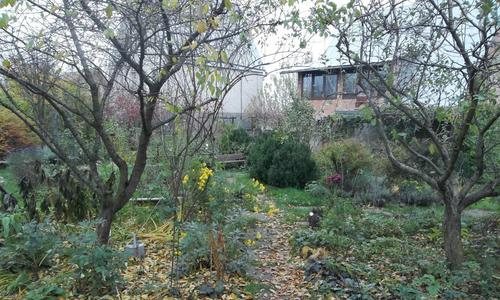

Do not use materials that increase the acidity of the soil (coniferous sawdust) for mulching apple trees. The mulch must be scattered, stepping back 10-15 cm from the trunk of the tree. Otherwise, decomposing plant residues will lead to fungal diseases of the trunk and root collar.
After watering, the soil must be loosened and mulched.
If on a flat area, furrows and ridges are often leveled during loosening, then on slopes to retain moisture around the trunk, permanent holes, rollers, and bowls are made along the diameter of the crown. Their purpose is to retain water and direct it to the root zone.
Watering apple trees can be carried out by surface, subsoil, drip methods or sprinkling.
Surface irrigation is carried out along furrows and special ditches in the aisles of the garden. Surface irrigation using a hose is performed along the circumference of the crown, and not the trunk of the tree. To do this, mentally lower a straight line from the longest side branches to the ground, draw a circle. This will be the area where the small suction roots are located.
Sprinkler irrigation is carried out by fan, impulsive, pistol and other types of sprinklers. Correct sprinkling - shallow, uniform, scattered. The soil should get wet by 60-80 cm. Shallow watering (5-15 cm) will only aggravate the position of the crop, especially in hot weather.
Sprinkler irrigation is carried out with any type of sprinkler
It is best to use drip irrigation.In this case, water is constantly delivered directly to the root system of the tree.
You can combine watering with liquid fertilizing. In hot and dry weather, sprinkler irrigation can be attached to drip irrigation to create a humid microclimate in garden plantings. It is better to spend it in the morning or in the evening.
Watering rates vary depending on the age of the tree. The first 1-5 years of life, seedlings need relatively small watering, which is carried out more often than adult trees. At one time you need:
- annual trees - 2-3 buckets of water per 1 square meter of trunk circle;
- biennial trees - 4-5 buckets of water;
- 3-5 year old apple trees - at least 5-8 buckets of water;
- adult apple trees (6-10 years old) that have begun to bear fruit - up to 60-100 l / m2 of the area of the trunk circle or until the soil gets wet to a depth of 60-80 cm.
- The soil on which the apple trees grow should be moderately moist. Watering young trees is directly dependent on rain.
- If it rains frequently, there is no need to water the tree. But it is important to loosen the soil, providing air access to the root of the tree. In this case, the forks must not be turned in the ground, otherwise it can lead to a violation of the fragile roots.
- If it is dry and warm outside, watering should be done 2 times a week. The norm of water for a young tree is 1-2 buckets.
- It's a good idea to water the tree in the evening using the sprinkling method, this method will wash away the pests from the crown and trunk of the apple tree.
- Do not water the tree when the sun is beating down outside. Such watering can lead to the development of tree diseases.
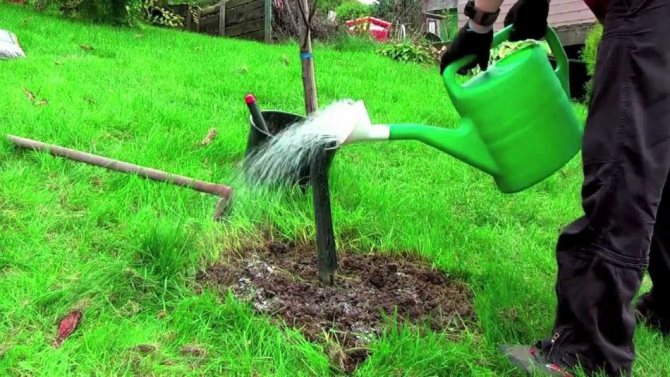

How often to water an apple tree in spring
In the spring
Watering
When we plant an apple tree in the fall, we need to understand that the first watering is most important for the further development of the plant. It not only provides the root system with sufficient moisture, but also compacts the soil.
Pouring water in one stream directly under the seedling is very harmful. For these purposes, use a simple watering can.
If the first watering should be abundant, then do not abuse the amount of moisture in the future. It provokes the appearance of a crust near the rhizome, blocks access to oxygen.
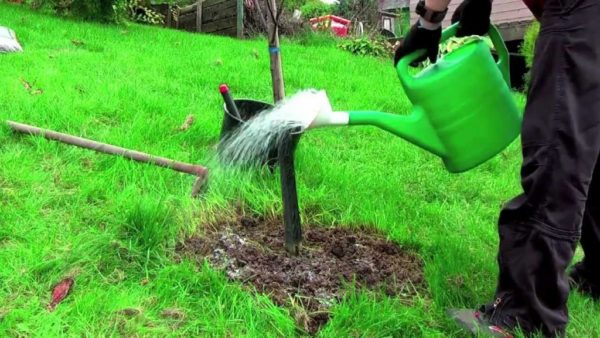

Use a watering can for watering.
IMPORTANT! It is best to water a young apple tree in the evening.
GROWS ON THE ROOTS: A DISEASE OR NOT?
Sometimes, under the influence of bacteria living in the soil, growths are formed on the roots (sometimes large, the size of a fist). Buyers do not like such seedlings, because they are sure that these trees are infected with root cancer and will not grow well. But the fears are not well founded. If the growths are dotted, do not encircle the root collar, they are not scary. Observations of Polish scientists have shown that trees planted in the garden with growths on the roots grow and bear fruit quite normally. But if the growths form a circle near the root collar, this is dangerous, such seedlings should not be bought.
FACT: IN SPITE OF THE PERIOD OF REST, THE ROOTS OF A TREE PLANTED IN AUTUMN WILL CONTINUE TO GROW UNTIL THE SOIL TEMPERATURE DECLINES TO ABOUT DEGREE. IN THE NEW SEASON, SUCH PLANTS WILL GROW INTO GROWTH 2-3 WEEKS BEFORE THAT PLANTED IN SPRING.
Correct care
In addition to the question of how to properly plant an apple tree in the fall, the question arises of further caring for the seedling. Young apple trees require that they regularly watered and pruned the branches... Pruning is necessary so that the tree begins to bear fruit faster and is more resistant to frost.
When planting at any time of the year cut the apple tree only in spring.
The first time the plant should be cut in the second year after planting. This is done in early spring before the buds begin to swell. At this time, you need to trim the crown and remove the dried branches.
New branches will begin to grow faster and the plant's yield will increase.
Mulching is also of great importance in caring for a young tree. It is best to do this with stale horse or cow dung or humus.
No need to cover the newly planted plant with a large layer of manure. A small amount, covered with mowed grass or straw on top with a 5 cm layer, will be enough.
Under this layer, ideal conditions for life and reproduction of earthworms will be created. and other living organisms that will provide good conditions for the apple tree.
How to properly plant fruit trees on the site
Agricultural technology for planting any type of fruit crops is practically the same type. However, using the recommendations of experienced gardeners, the question of how to properly plant an apple or cherry in the spring can be solved more competently, taking into account the characteristics of the plant and the specific requirements for its planting.
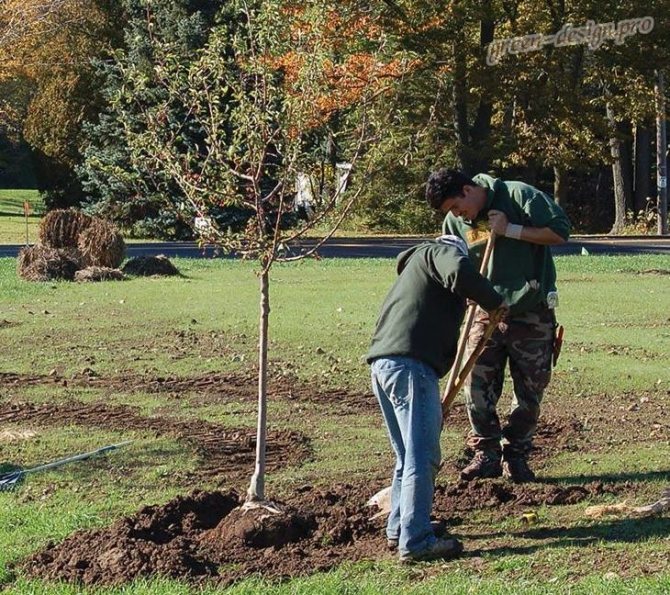

Apple tree
Apple tree seedlings will require a hole 80 cm deep and up to a meter in diameter. At the same time, it is better to make the side walls with an angle of 60 °. The apple tree prefers soils with normal acidity. Lime can help balance acidic soils, but it is brought in in the fall so that in the spring the earth does not have purely limescale lumps that can harm the root system of the tree.
The distance between the apple trees when planting should be from 4 m, and if an orderly garden is planted, then the row spacing will be 6-7 m.The depth of the pit for the cherry is usually from half a meter, and its diameter is 0.8 m. The row spacing is approximately 3 m, as well as indent between trees in one row.
Pear
The sunny south, south-west and west sides of the site are perfect for pears. Not everyone knows how to plant a pear correctly in spring due to the peculiarities of the root system of this tree. It is for the most part vertical and requires the use of the taper pit method.
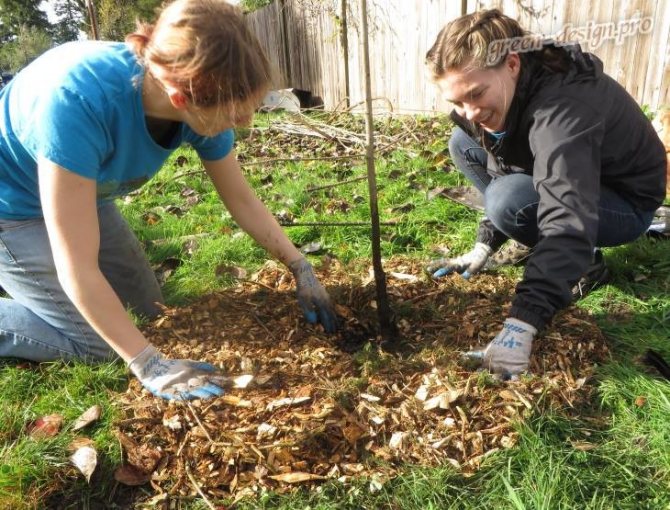

The soil for this mound is mixed with fertilizer (mainly autumn application of organic matter). The roots are laid on such a hump and straightened along the entire length.
Plum
How to plant a plum in spring can be a tricky question. This tree often becomes the reason for the presence of unsuitable territories in the plots, due to the large number of young roots that have broken through in the spring from the main rhizome, which are almost impossible to remove. And all because the central tree was planted too deep. In order to prevent the roots from spreading beyond the diameter of the crown, you can also use the fencing method, digging in a thick oilcloth around the perimeter. But it is better to follow the advice on proper planting. You will need to make a shallow hole with a mound in the middle, like a pear. And it doesn't matter if the rhizome grows above the ground in the near-stem area. These are the so-called arteries of the tree, which act as veins, and the small roots in the soil will take care of the delivery of moisture and nutrients to the trunk.
Features of planting in frost
It happens that it was too late to buy a seedling. Many are tempted to cut prices. According to the rules, all deadlines have been missed. Is it possible in this case and how to plant an apple tree in the fall in frost? Are there any technologies for planting a tree at subzero temperatures?
Important! Experts advise that it is better to postpone all activities until spring, and at this time make sure that the seedling is viable by the onset of the warm season.
You can store a young plant in a cool cellar. To do this, you need to place the root system in a container with peat or sawdust. In the room itself, the temperature should not drop below zero. If you water the apple tree at least once a week, you can plant it in early spring.
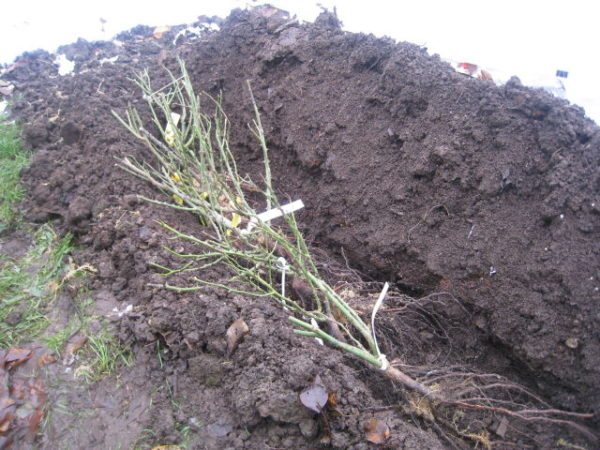

Digging in apple seedlings until spring.
In snowy regions, it is also possible to store the seedlings under a sufficient layer of snow (assuming the seedling is well packed). Snow will keep the temperature from dropping around the plant below its vital level.
Features of winter sowing of vegetables
The most important thing to know is that if snow is blown away by the wind on your site in autumn and spring, during the period of the most abundant rainfall, or in winter, you need to give up the winter crops.
If the autumn is very long, do not worry, any winterized vegetables, including radishes, can be sown all winter while the road to the garden is available.Even in December or January, while the temperatures are slightly minus (-3-5 ° С).
The main thing is to prepare the beds in advance, because we will sow practically in the snow, sometimes after the first snow, on hard ground.
After harvesting at the end of summer, when the land is soft and future planting is planned, taking into account the crop rotation, we dig up the soil, removing weeds. If necessary, we apply fertilizers depending on the needs of the crop. For example, carrots do not tolerate organic matter; we do not add humus or manure to its beds.
It is imperative to level the ground, break up large clods and make grooves in advance - on the day of sowing, you are unlikely to succeed - the ground is frozen.
So, the holes have been prepared, you need to stock up on dry earth for sprinkling seeds, fill it in buckets or bags and leave it in a country house or a shed where it will not freeze.
On the day of planting, it remains only to distribute the seeds along the grooves and sprinkle with the harvested soil. If necessary, mulch from above with leaf litter, spruce branches or straw.
What flowers to plant in autumn
How to plant an apple tree in the fall: a step-by-step guide
- Place the seedling in the ground shortly after purchase, so that avoid drying out the root system.
- The belief that a large seedling will take root better is a myth. In fact, they adapt much worse to new conditions.
- Trees should not be planted in an unprepared hole. Be sure to use fertilizers. However, mineral fertilizers should not be abused. There is a risk of burning young, fragile roots.
- After planting, the young plant should be watered immediately. This is necessary not only in order to saturate the tree with nutrients, but in order to compact the soil to the required state. For this purpose, you must use a watering can. If the season is not rainy, then the tree should be watered regularly (at least once a week) before frost. Until the soil in the planting pit is compacted enough, you need to use watering cans. Only then can you start using hose irrigation.
- Usually apple trees are recommended to be planted at a distance of at least 4 meters from each other. For low-growing trees, this distance can be reduced to 3 meters.
Preparing the landing pits
It is unacceptable to lay manure in the planting holes. They are filled with well-rotted compost, humus. On acidic soils, humus is mixed with lime. It is good to add double superphosphate to the fossa. But in no case should urea, ammonium nitrate or other nitrogen fertilizers be placed in the planting hole in the fall. It is permissible to mix a liter can of ash with the soil.
Planting pits are prepared in 3-4 days, the soil is squeezed well so that it settles. If this is not done, after planting the plant, the soil in the hole will settle, with watering and rains, it will wash additional soil into the depression and the tree will be re-buried. This is also a common cause of poor seedling growth in the early years and a long absence of fruiting. Raspberries, like fruit trees, do not like burrowing. But gooseberries or currants can be planted deeper, the covered part of the stem will overgrow with roots, the plant will only benefit from this.
Features for different regions
We already mentioned at the beginning that the peculiarities of how to plant an apple tree in autumn largely depend on climatic conditions.
- In outskirts of Moscow it is best to plant apple tree seedlings in the fall from the third decade of September to the end of October. In November, frosts may already begin in these places, and for young plants they are often destructive.
- Leningrad region known for the poverty of its soils, so special attention should be paid to fertilizing the planting pit. The best time for gardening activities is late September - early October.
- In central Russia you also need to take into account the time of the onset of the first frost. Mid September - the first two weeks of October will also be ideal.However, due to the weather, it is sometimes better to postpone the planting of the apple tree in the spring.


Landing dates depending on the region.
- In the south of Russia this period can extend to early November. Always keep an eye on the weather forecast though. Nobody cancels the sharp onset of cold weather.
- Frosty Siberian winters it is very difficult for young trees to survive. In these regions, it is better to postpone the planting of an apple tree until the beginning of spring.
- No less destructive and Ural climate for seedlings... Most likely, they simply will not have time to adapt to the new land, and the early frost will destroy them.
Advice! Experienced gardeners recommend that planting apple trees in autumn in Belarus should also be completed as early as possible. It is advisable to complete the entire process by mid-September.
Ukraine is famous not only for its fertile soils, but also for the favorable conditions for the autumn planting of apple trees. Autumn seedlings will take root better than spring ones in the southern regions of the country.
What vegetables to plant in autumn
Onion sets per turnip
Onion sets measure 1-3 cm in diameter, but we plant the smallest, 0.8-10 mm in size. It is in the fall that such an onion set is available (sold in every market), which has a great advantage - a small set does not form flower arrows, the greens from it are weak and small, but the bulbs ripen already at the beginning of July.
- Planting pattern: 4-5 cm between bulbs in a row, 12-13 cm between rows.
Plant in late September - early October or early November in southern regions.
The best varieties: Onion sets Carmen, Sturon - they shoot less.
Onions on greens
Planting material - onion selections or large onion sets. The best yield is yielded by large multi-primordial onions, which have a bulb diameter of 3-4 cm, the greens from it are juicy and tender. It is necessary to plant onion sets in late autumn, 2 weeks before stable frosts, so that the roots have time to bite, take root, but feather growth does not start.
In central Russia, the optimal time for planting onions on greens before winter is late September - early October. Lower Volga region, southern Russia - late October - early November. The depth of planting in the soil is 4-5 cm, then a layer of mulch about 10 cm high from humus or peat, until spring - early spring, mulch is needed. There is no need to water the sown seedlings!
Black onion before winter
Onions are propagated not only by bulbs, but also by seeds, which are black, so this is the name. The peculiarities of sowing before winter is that we do not have the opportunity to soak the seeds and reject those that will not drown (empty ones float up), in addition, the changeable weather in winter will automatically lose part of the crops, that is, the seed material needs to be increased by 15-20%.
Planting dates are roughly the end of October or November, when the ground is already freezing, you can sow under the snow, quite late, even in a thaw in winter, it is important to know that at a temperature of + 2-3 ° C, blackberry seeds begin to germinate, we do not see this ( in warm weather, shoots in 2.5-3 weeks). Therefore, it is necessary to prevent germination in the fall, but in the spring the earlier the onion rises, the better, so it is worth sowing in raised beds (20-25 cm high) - they warm up faster with the spring sun.
- Sowing pattern: up to 2.5 cm between shifts, 18-20 cm between rows. If the seedlings are thick, you need to thin out. Sowing depth 1.5 cm.
Crops of black onions in regions with harsh winters need to be mulched with 3-4 cm of humus or peat, it is possible with leaf litter or sawdust.
Varieties: Danilovsky, Myachkovsky, Strigunovsky, Odintsovsky.
Garlic
Winter garlic is planted in the second half of September - early October, or about a month and a half before the onset of persistent cold weather. For planting, we choose large cloves from large bulbs - the larger the planting material, the larger the heads of garlic will grow in the next years.
We divide the head of garlic into teeth on the day of planting, first removing the bottom (its remnants will prevent the teeth from germinating).
- Planting pattern: 15-20 cm between teeth in a row, planting depth 4-6 cm, distance between rows 20 cm.
Planting garlic should be mulched with peat or humus with a layer of about 5 cm. Remove the mulch in early spring, in more detail - "planting garlic before winter"
Carrot
Carrots are sown with seeds in spring and before winter, podwinter sowing has a number of advantages, although it is practiced less often - the risks of death of seeds (seedlings) due to unstable weather are too great. The biggest difficulty is to guess the sowing time so that the carrot seeds do not germinate, as well as to sow nigella 1.5-2 weeks before frost, when the ground is already frozen and dries up slightly. Reference point - stable air temperature not higher than 2-3 ° С. Seed consumption is 15-20% more to cover winter losses.
- Sowing scheme: between seeds 2-2.5 cm, between rows 20 cm, planting depth 2-3 cm.
Read more - "planting carrots in the winter"
Beet
Beets, like carrots, can be sown in November, before frosts, but the choice of varieties is very small: they mainly sow Cold-resistant-19 and Podzimnyaya-474 beets, Bordeaux. The rest of the varieties are shooted from the cold.
- Sowing scheme: between seeds about 10 cm, between rows 20 cm, planting depth 2-3 cm.In addition, a layer of mulch 3-4 cm, which should be raked in the spring.
The problem of sowing carrots and beets in winter is the same - unstable weather in winter leads to the fact that vegetables in spring have poor, rare shoots, and they are immediately "clogged" by weeds. Therefore, it is worth increasing the density of crops by at least 15% and considering the feasibility of such work.
Radish
But radish with podzimnym sowing, on the contrary, is often justified - sowing in early November, the harvest ripens by mid-late April, if the spring is long - by May. As in all other cases, there is no exact date for sowing, it is important that the seeds do not germinate in time. We focus on the time when the temperature is about 0- + 1 ° С. If a thaw is predicted, you need to wait.
- Sowing scheme: between seeds about 3 cm, between rows 10-15 cm, planting depth 2-3 cm.In addition, a layer of mulch 3-4 cm (sawdust, straw, leaves, peat), which in the spring needs to be covered with foil or agrospan until the snow will begin to melt.
Unfortunately, many varieties of radish are prone to shooting, preference can be given to the following: Mokhovsky, Soffit, Dungansky, Wurzburg, Red giant, Variant.
Leaf parsley
Before winter, leaf parsley seeds are sown in October-November under frost, although leaf parsley is quite cold-resistant - it germinates at + 2-3 ° C, and the seedlings hold out until it is colder than -7-9 ° C, we need to sow on days such that the seeds sprouted only in the spring. By the way, parsley planted in spring takes a very long time to sprout and grows slowly, so sowing in winter will seriously speed up the time needed to obtain fresh greens.
Sowing scheme: the distance between the seeds is 2-3 cm, the distance between the rows is 15 cm, the depth of planting in the soil is about 1.5 cm. More details - "Leaf parsley - growing and care".
Leafy, head and watercress salads
Salads germinate well in spring, amicably, grow quickly, but some gardeners sow this culture before winter. Sowing dates: late October - early November, or later, if the autumn is protracted.
Suitable varieties are mid-ripening and late-ripening varieties: Large cabbage, Emerald, Berlin yellow. Early: Riga, Moscow greenhouse and New Year's is better to sow in the spring in greenhouses or greenhouses.
If you are an enviable owner of a heated greenhouse, then leaf, cabbage and watercress salads can be grown all winter, the choice of variety in this case depends on the possibility of additional lighting. But it is still advisable to choose more shade-tolerant varieties, for example, the cabbage variety Dachnitsa.
Sowing scheme: in rows, with a distance of about 20 cm between them, to a depth of 1-2 cm, sow the seeds with a continuous ribbon, thin out when shoots appear.
Parsnip
This root crop is sown before winter as well as carrots. Seeds are only freshly harvested, parsnips do not germinate well and quickly lose their germination.Germinates at a temperature of + 4-5 ° C, therefore sowing in late autumn, without soaking.
Grades: Student and Guernsey.
Sowing pattern: 10-12 cm between seeds in a row, 20 cm between rows, seeding depth about 3-4 cm.
Physalis
Physalis is a plant that has been undeservedly deprived of attention; a relative of tomatoes has a specific taste. We are interested in the varieties of vegetable physalis - this is Korolek, Gribovsky soil, Moscow early, Large-fruited, Likhtarik, as well as Physalis strawberry, Peruvian and Physalis raisin.
Physalis is grown from seedlings in spring, seeds are sown in autumn. Sowing dates - in October - November, in fact, physalis reproduces well by self-sowing - the falling fruits rot, and the seeds germinate in the spring.
Sowing scheme: the distance between seeds is 50 cm for berry (Peruvian) physalis, 60-70 cm for vegetable (Mexican). The distance between the rows is not less than 70 cm. The depth of planting seeds before winter is 1.5-2 cm (in spring 1 cm).
Dill
Dill in our gardens often grows self-sowing - these are practically wild plants, there is not much greenery from them, only umbrellas for pickling cucumbers and tomatoes are good. If you need exactly lettuce greens of dill, it is worth choosing varietal, good for winter sowing: Gribovsky, Abundant, Umbrella, Dalny, Grenadier.
Sowing dates for the middle lane: late October and early November, given that at + 3-4 ° C, dill germinates.
Sowing scheme: between rows 15-20 cm (depending on the height of the variety), sowing in rows with a continuous ribbon, the excess can be thinned out in the spring. Seeding depth 2 cm, cover crops with leaves or straw.
Selection of varieties
Columnar apple trees, which appeared some 40 years ago thanks to the efforts of breeders, are very popular among gardeners.
Like other types of fruit trees, such apple trees are recommended to be planted in spring or autumn (no later than the end of September).
The survival rate of dwarf apple trees also depends on the planting time. In the fall, such seedlings need to be replanted when growth partially stops and some leaves fall off.
Particular attention must be paid to ensure that the roots of the tree do not remain exposed for a long time in the air. Because of this, they can dry out. Otherwise, the standard rules should be followed.
ABOUTusually apple trees are planted with two-year-old seedlings, however, one-year-olds can take root well.
To do this, they need to be booked. For autumn planting, this procedure is carried out in the spring.
Criteria for evaluating the site for the correct selection of seedlings
The first thing to start with before going to the market, nursery or garden center is to carefully study your site and evaluate the possibilities of growing a particular tree.
Ground water
If in your area groundwater rises so that less than two meters remains to the surface of the earth, then, alas, you will have to refuse to plant trees with a deep root system. And now most of the seedlings of apple, pear, sweet cherry are grown on seed stocks with a deep root system. There are, however, undergrowth trees, and this may be a way out of the situation.
Soil acidity
If you have weakly acidic soil on your site (pH value below 5.5), then for growing stone fruit crops (cherry, sweet cherry, peach, apricot) additional laborious work will be needed to reduce acidity (liming), and not one-time, but regular. Are you ready for this?
Wind
This problem is typical for newly created gardens, as they say, from scratch. Most fruit trees do not grow well in open, "blown by all the winds" areas, especially thermophilic species. They may grow, but in a frosty winter with a strong wind they will be very weakened. And in the spring they will come to their senses for a long time, and not "work" to give you a harvest soon.
Shadow
If you dream of a fruit garden in a natural style or on the border with a forest, then you should forget about large harvests.With a lack of light, fewer flower buds and, accordingly, ovaries are formed.
Features of the landscape
If the site is located in some kind of natural depression in the area (in a valley or ravine), then keep in mind that all the cold air will be collected from you. Therefore, you will have to choose seedlings that are more frost and winter hardy. And because of the high humidity in the lowlands (fogs), fungal infections will annoy your garden more. We'll have to look for disease-resistant varieties. It's good that there are such people.
Carrot
Experienced gardeners know that carrots respond best to planting before winter. The seeds take root well, undergo acclimatization on their own, without requiring additional nutrition. In addition, carrots tolerate cold and frost well, so there is no need to cover the beds for the winter - the snow will serve as the best blanket for it. When the temperature reaches the optimal level in spring, the carrots will begin to sprout and yield intensively.
It is necessary to plant seeds dry in dry beds, approximately at the end of October, when the air temperature reaches + 2-3 degrees. It is advisable to purchase special autumn carrot varieties. Sowing scheme: between seeds 2-3 cm, between beds 25 cm, laying depth 3 cm.
Planting seedlings
First of all, we plant winter grafts of seedlings that were stored in a cold basement or rootstocks dug for the winter.
Carry out a revision: examine the root system of the plants, remove rotten roots until healthy tissue (it is light in color). Cut the cuts in a straight line, without sawing, with a very sharp knife - the smoother the cut, the faster the callus forms. If the seedlings have cuts or breaks on thick roots, sprinkle them with crushed coal.
If you have purchased seedlings whose root system is covered with a clay mash, you need to wash the roots from it!
For planting in a plot prepared in the fall and filled with nutritious soil, we dig a hole, but not over the entire area where the hole was dug in the fall, but much less - the deepening should be sufficient for the root system of the seedling to fit freely in it, but no more. The depth is such that the root collar of the seedling placed in the hole is at ground level. Do not let it go even 5-7 cm deep.
The root collar of a seedling is where the first roots extend from the trunk. Not to be confused with the grafting site - it is about 10-15 cm higher than the root collar.
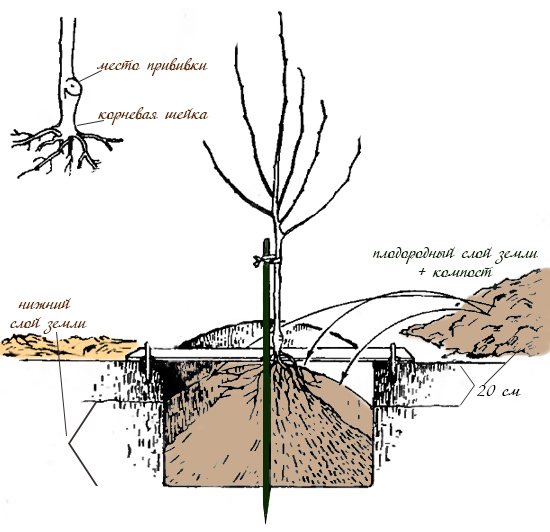

To plant the seedling at the correct depth, use a level - a long stick laid across the hole so that the ends lie on a flat ground around the hole.
It is better to plant the seedlings together, so that one person holds the tree by the trunk, keeping its even vertical position, the second one digs in. If the seedling has a lot of roots, when covering it with earth, you need to shake it slightly by the trunk so that the earth is well distributed into the voids between the roots.
Do not compact the soil around the planting site too vigorously. Just water the soil, when the ground settles, throw more. In the first two weeks, the earth will be caked, and if necessary, you need to huddle again if the root collar is exposed.
After digging in the seedling, you need to form a near-trunk circle around it, or a "saucer" for watering. With a diameter of about 50-60 cm, a height of 7-10 cm. Be sure to fix the trunk of the seedling - stick a wooden peg into the ground next to the trunk. It is important to sharpen its lower end sharply so that it does not tear the roots of the tree, but easily passes between them. Tie the trunk to the support using jute or a piece of nylon tights. Do not use wire or fishing line for tying!
If you plan to use not a thin peg as a support, but a large pole, you need to sharpen its end and drive in the pole before planting the seedling!
After planting, it is necessary to water the plant abundantly, the near-trunk earthen circle will not allow water to spread over the site. Watering is necessary in any weather and soil moisture.After watering, the earth becomes heavy, settles and compresses in a natural way. How much water to pour: a full bucket, but not at one time, but in two or three doses.
When planting winter-grafted seedlings, a month after planting, you need to remove the film strapping.
Landing dates
We cannot talk about specific dates for the autumn planting of fruit crops, especially now, when the climate is changing before our eyes.
The general rule is this: in the fall, fruit crops are planted two to three weeks before the onset of frost (this is exactly how much is needed for rooting). Gardeners are looking at their climate, but in most regions apple, pear and fruit shrubs can be planted before the end of October. The air temperature can even be below zero, but it is very important that the soil does not freeze to the depth of the roots.
The soil should be soft, not petrified.
Andrey Vasiliev
-5-10 degrees to seedlings absolutely to the light bulb, even if zoned, even Golden Delicious. If they are OKS and without leaves and if they are properly grown ZKS (there is no need to cut off their leaves and can be planted even in December, if the root ball is not disturbed).
But if, due to the frozen soil, the seedling did not have time to take root, did not have time to grow roots into the soil, then in winter, especially unfavorable for plants, it will freeze out with great probability.
Experienced gardening tips
When buying seedlings, pay attention to their external condition. Seedlings can be with unripe shoots if they were dug out before natural leaf fall.
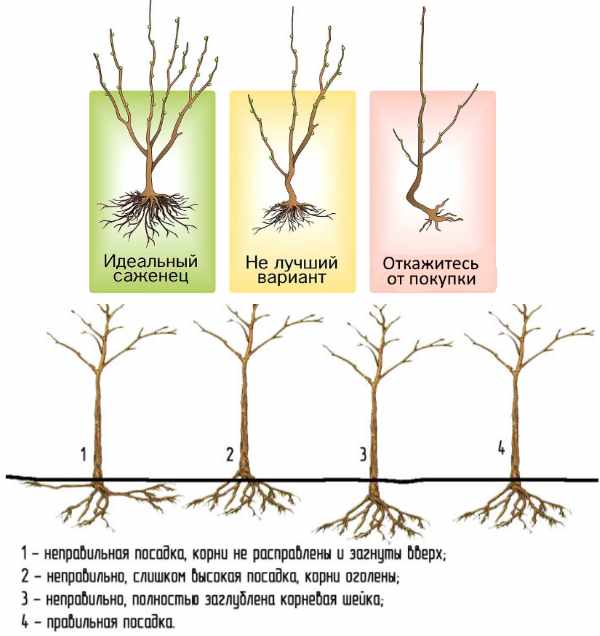

Trees with numerous leaves may not be ripe and dry, since most of the moisture loss occurs through the leaves.
Planting scheme for fruit trees
Fruit trees are light-requiring, so choose southern sites for planting seedlings. You can plant trees in steps - tall to the north, undersized to the south, and everyone will have enough light.
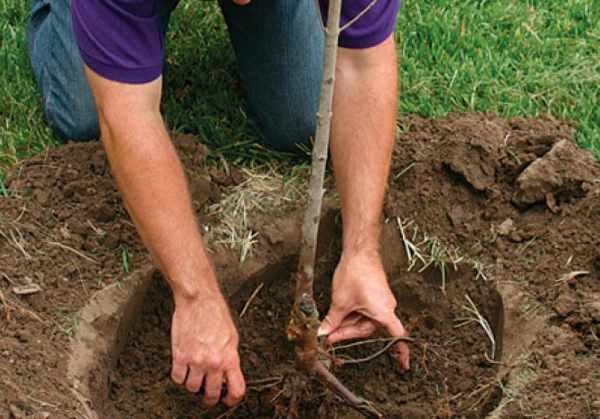

Also take into account the distance to buildings and communications from trees, it must be at least 4.5 m. When planting, you must know the size of the crown and root system. The roots of mature trees can even damage the foundation.
Combine trees on the site correctly:
cherries grow well next to apricots. The nut oppresses all the trees that grow next to it. Do not plant apple and peach together. For more information on the compatibility of fruit trees, see
Video - Fruit tree compatibility.
Back to the table of contents
Radish
Sowing of this crop is often carried out in the fall. Seeds are applied to the ground in early November. The crop can be harvested in mid-April. Roughly planting radish seeds in the ground should be at a temperature of about + 1 ° C. If there is a thaw, they will sprout and die. Therefore, it is better not to rush to sowing.
A distance of about 30 mm is made between the seeds, and 100 mm between the rows. The depth of the holes is 30 mm. The beds are covered with a layer of sawdust or peat 35 mm. In the spring, until the snow begins to melt, the crops are covered with foil.
WHAT PLANTS IS BETTER TO PLANT IN AUTUMN (VIDEO)
Another really deserved plus of the autumn planting of flowers can be considered its own convenience in work in the country. Now you don't have to waste time planting flowers, re-looking for a favorable area for them, constantly worrying about the temperature of the external environment and the warming up of the soil - that's it, you have already planted everything and get healthy plants, which means you can do other, no less important things ...
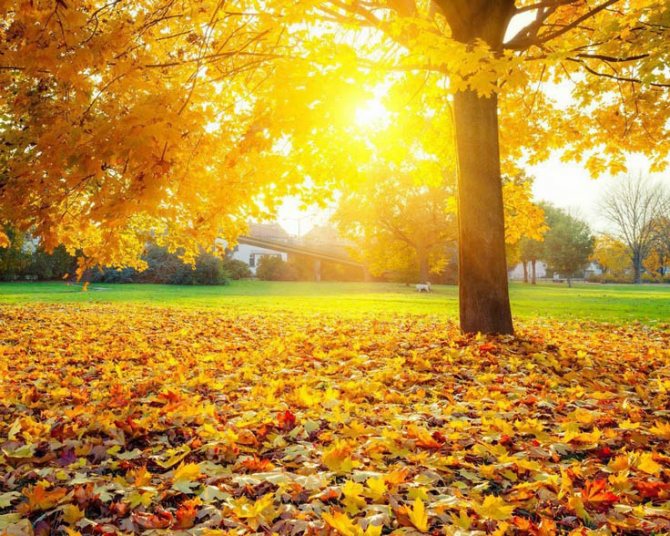

Autumn seedlings that have sprouted will really save your time and energy, because spring work in the country is not simple and, like autumn work in the country, is characterized by serious spending of free time.
Autumn plantings of flowers begin to develop on time, sprout strictly at a certain period, which means that they are already completely subject to the natural cycle.
Planting fruit trees
Gardens are laid in areas with different topography, groundwater levels and lighting.However, there are certain rules that must be followed when planting a garden, regardless of its location.
It must be remembered that improperly planted trees do not take root well and grow, which can lead to their death.
rules
The planting of fruit trees is carried out in accordance with certain rules, which not only ensure the survival of plants, but also improve the volume of fruiting in the future.
The basic rules for planting fruit and berry crops include several important points (Figure 5):
- The pits must be prepared two weeks before the planned planting. Moreover, their size depends on the quality of the soil, but should not be less than 50-60 cm in depth and width.
- When digging holes, the soil is laid out in two parts: the upper fertile layer and the lower, less fertile, separately. The bottom layer is enriched with nutrients by adding compost to it. The use of manure for this purpose is not recommended, since even in a rotted state it can damage the bare roots of plants.
- The bottom of the pit must be loosened to improve air access to the roots of the plant. If the soil is sandy, then a layer of clay 15 cm thick is laid on the bottom of the pit, which will retain the necessary moisture.
- A few days before planting, the pits are filled with fertilizers (2-4 buckets of humus, phosphorus - 200 g, potassium chloride - 100 g, wood ash - 1 kg per pit 60-100 cm in size). All fertilizers are mixed with the soil, which is intended for filling the hole. If the hole was dug and filled in the fall, then this work is not carried out in the spring.
- Before placing the seedling in the center of the pit, it is necessary to drive a stake 5-6 cm thick and 1.3-1.5 m high from the leeward side.
- The planting material must be carefully examined, all damaged or diseased branches and roots must be cut off.
- You can keep the seedling in a container with water for 1-2 days so that its root system accumulates a sufficient amount of moisture for quick engraftment. It is also recommended to dip the root in a mash of clay and manure (clay, mullein, water in a ratio of 1: 2: 5), which will ensure good contact of the roots with the soil.


Figure 5. Features of planting fruit and berry trees
Immediately before planting, a mound of soil filled with fertilizer is poured onto the bottom of the pit, then a seedling is placed on it from the north side of the stake and the roots are straightened. The hole is covered with a fertile layer of earth, removed when digging the hole, compacting it and regularly shaking the seedling. This is done so that voids do not form between the roots. Ultimately, the root collar of the seedling should be slightly above the soil level in the garden in order to level with it after watering.
After planting along the diameter of the pit, the soil is poured with a roller of small height, and the circle itself is watered with 5-6 buckets of water. The tree itself must be tied to the stake.
The trunk circle must be covered with organic material to prevent the formation of a surface crust and help retain moisture.
Features of the
When choosing seedlings, it will be useful to know their age, because this significantly affects the survival rate of trees. For example, apple and pear seedlings should be 2-3 years old, while cherry and plum seedlings should be 2 years old. When deciding on varieties, heed the advice of experienced gardeners.
Note: Place the plants in the garden in rows at a certain distance from each other. So, pears and apple trees are planted at a distance of 6-8 meters, and cherries and plums - at a distance of 3 meters between tall fruit trees and 3-4 meters between rows. You can also occupy the aisles with currant or gooseberry bushes. It will be great if the rows of the garden are located from east to west. So they are better illuminated by the sun in the morning.
To mark up a plot for a garden, you first need to draw its plan, where to provide for the boundaries and arrangement of rows, paths and flower beds (Figure 6).On the ground, the breakdown is carried out using a rope, tape measure and pegs. The rope is needed to determine and mark the distances that will be observed during landing. It stretches along the future row, and with the help of knots or scraps of fabric, you indicate the landing sites. Here it is necessary to ensure that the rows are even. It is not only beautiful, but also easy to care for.
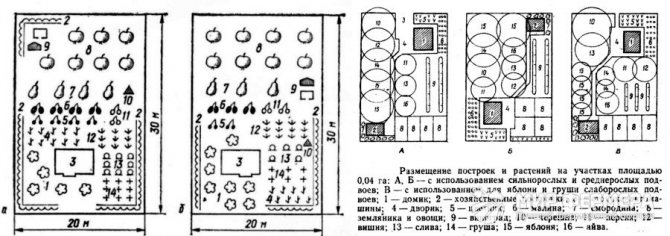

Figure 6. Scheme for placing trees and shrubs
It is recommended to tie the planted trees to stakes to protect them from excessive swinging. To do this, use a regular washcloth, which must be fixed on a support in the form of a figure eight so that the seedling does not damage its tender young bark about the stake.
In addition, after planting a tree, you need to prune its branches. In this case, strong shoots must be shortened by half, and weak ones - a little less. As a result of trimming, the ends of the skeletal branches should end in the same horizontal plane. The central shoot is cut so that it is 20-30 cm higher than all the others. Both the lateral and central branches are cut above the outer bud.
Compatibility of fruit trees and shrubs when planting
Experienced gardeners have long noticed that some fruit trees and shrubs feel uncomfortable next to other plants or, on the contrary, successfully coexist with them. In the first case, plant roots can be at the same depth and interfere with each other. A situation happens when one of the plants releases substances into the soil that suppress the development of others. Therefore, when planning the planting of fruit and berry plants, do not be too lazy to look at the table of their compatibility (Figure 8).
For example, apple trees can get along with almost any garden crops, except for mountain ash. Red and black currants do not tolerate neighborhoods with each other and with raspberries, since their root system oppresses the neighboring plant. For this reason, it is recommended to plant raspberries in a separate area. Gooseberries cannot coexist with black currants, and they are not friendly with raspberries either.
You will find more information on the compatibility of fruit and berry crops in the video.
ADVANTAGES OF AUTUMN FLOWER PLANTING IN THE DACHA
At first glance, it may seem that autumn crops are a mockery of plants, but you would be wrong: after all, planting flowers before winter has a number of advantages.
The first and most obvious advantage can be considered the hardening of plants - after all, those seeds that survive the winter and sprout will be really strong and very resistant. In addition, plants will be able not only to demonstrate good health in the warm season, but also to perfectly resist many diseases that will quickly “eat up” weak plants.
Autumn sowing of flowers can easily withstand spring frosts, which, even on May nights, do not tolerate very many shoots. Hardened plants will quickly form a strong and healthy root system that will reach the moisture needed in the depths of the soil and prevent the plant from dying. In addition, this fact indicates a lesser need for watering, which means that it is more likely to resist diseases.
Onion sets
Onion sets are perfect for sowing in the fall. It is well preserved in the ground and practically does not die out from strong temperature changes. The bow does not shoot arrows and gives a good harvest in late spring - early June. It is better not to plant a turnip so that it has time to take root and acclimatize. There is no need to fertilize and cover the seedlings for the winter.
It is optimal to plant small onions with a diameter of 0.5-9 mm. When planting, follow the pattern: 3-6 cm between bulbs, 15-17 cm between rows. Suitable time for sowing is early October, recommended varieties: Carmen and Sturon.
Watering a tree between the ages of 3 and 15
Trees from the age of 3 years are no longer so demanding for watering. As a rule, they are watered only in very dry summers or during the period of fruit ripening.
It also requires abundant and regular watering in the fall.This enables the tree to be better prepared for winter and to a large extent to avoid frost damage.
Abundant autumn watering is especially useful for plums and cherries. Stone fruits are vulnerable in the winter cold, but if they are well watered in the fall, then the winter will pass without much damage.
Pre-winter watering is carried out after the leaves have fallen from the trees. At the same time, pay attention to the fact that different species and varieties shed their leaves at different times, therefore, watering in the fall for each tree is individual. If possible, water 2 buckets per tree once a day for a week. In most cases, this is sufficient.
Dill
It is customary to plant dill in the fall in order to get a harvest closer to spring. During this time, the fragrant seasoning takes root, takes root and germinates with the onset of heat. It is necessary to plant dill in dry warm weather; you do not need to water the beds after planting. Seeds undergo natural stratification on their own and do not require additional feeding. It is not necessary to plant dill in rows; use a chaotic arrangement.
Planting scheme: despite the chaotic arrangement of seeds in a row, a distance of 20-25 cm should be observed between the beds, while the laying depth is 2 cm. Some varieties, such as Umbrella, Grennader and Gribovsky, require mulching. It is recommended to cover the seeds with straw or humus.
How to properly add seedlings in the fall
If it is already clear that with the autumn planting in all terms the gardener was late, and the seedlings were received, it is better to dig them in.
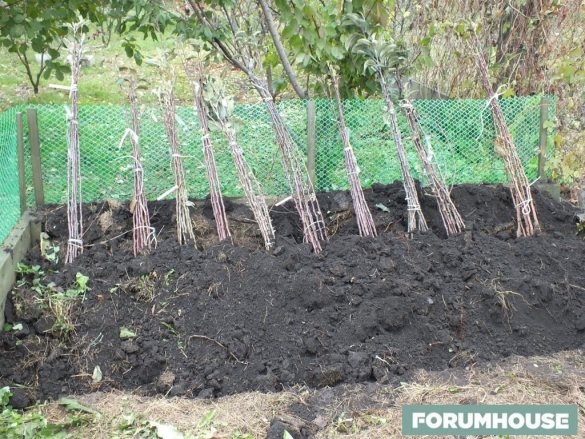

The seedlings are buried under a strong slope, so two-thirds of the trunk is covered by the soil, and the rest is snow, and the seedling is stored until spring, like in a refrigerator. You need to dig in in a place where there will definitely not be a puddle in the spring after the snow melts, it is also important that the place of the ditch and the place of future planting thaw out at the same time, that is, exactly not in the shadow of a building or fence. In autumn, you need to decompose the poison from the mice, water it well and cover it with spruce branches, and in winter trample the snow.
Andrey Vasiliev
In order to create a working refrigerator for as long as possible, so in winter I sprinkle snow into the hole, layer by layer sprinkling a snowdrift with sawdust and shading it with spunbond.
When to plant: in spring or autumn
Trunk circles of fruit trees - decoration
Novice summer residents often wonder when it is better to plant fruit trees: in spring or autumn. To choose the optimal time for gardening, first of all, you should take into account the climatic region:
- in the southern regions (Krasnodar, Stavropol Territories), spring passes quickly, and May is hot; if trees are planted this season, then they will root badly, hurt for a long time, will lag behind in development and will start to reproduce later than those that are planted in the fall;
- for northerners, the optimal period is spring, closer to mid-May, when the soil warms up and the air temperature becomes comfortable for planting; autumn is not acceptable here, since winter can come early and unexpectedly, destroying the seedlings;
- the middle band is average, which has absorbed the features of the border regions; here, landings are carried out in spring and autumn, based on weather conditions that do not occur year after year.
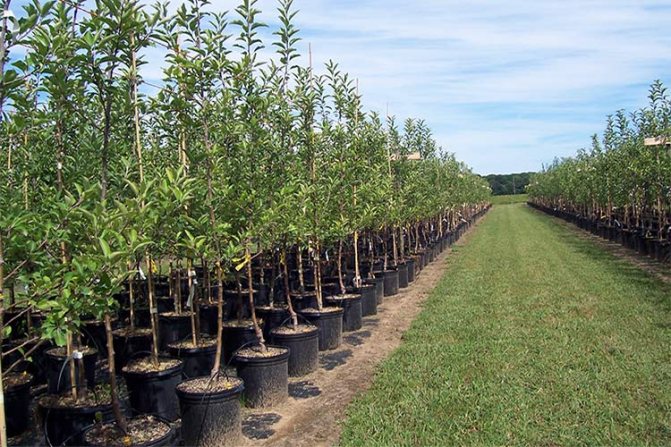

Saplings
Having chosen a suitable month for planting work, it is recommended to look at the Lunar calendar, which is published annually in periodicals to help "junior gardening". The astrological document indicates the best days when planting fruit crops is recommended.
You should not ignore this information, because they have been using this method since ancient times (and not only in Russia). The moon actively influences all biological processes taking place on Earth, this fact has been proven by science.
Landing errors
Out of inexperience, novice gardeners make the following mistakes:
- Wanting to get the harvest earlier, they buy mature trees. Saplings older than 3-4 years old are more difficult to take root.
- Violation of the planting rules will sooner or later affect the condition of the tree. It is too late to correct such errors. And it's not always possible to recognize the cause. The deepening of the root collar will affect within 2-3 years, and the gradual damping of the bark will destroy the apple tree in 5-6 years.
- Mulching with fresh sawdust is unacceptable. Only rotted ones are used.
- The pit is charged only with matured organic matter. Fresh manure or dung will burn the roots.
- Nitrogen application in autumn is also a mistake. Nitrogen stimulates vegetation, therefore it is needed in the spring.
By purchasing apple trees from local producers of planting material, the summer resident will receive a variety suitable for the region. But planting trees brought from areas with different climatic conditions is dangerous. Apple trees from warm regions will not survive in Siberia.
What to look for when buying?
If you do choose seedlings yourselfyou should remember the following:
- the seedling must be even and flawless;
- there should be no signs of disease on it;
- if the seedling is sold in a container, the roots should not grow through the drainage holes;
- any damage to the roots is unacceptable. Overdried roots also indicate that the plant is not viable;
- earthen lump - again not overdried! - should be of the same volume as the crown of the tree;
- leaves on the seedling should be completely absent.
Planting fruit trees
A well-groomed orchard is not only a wonderful decoration for your summer cottage, but also a rich source of vitamins.
It will take a lot of effort and time to grow it like that. And our article will also equip you with the necessary baggage of knowledge and rules that will help in the cultivation of an orchard.
rules
Sometimes it happens that the seedlings were of high quality, and the pits were prepared on time and appropriately, and the garden still did not start growing. Most often this comes from the ignorance of the novice gardeners of the rules for placing seedlings. It is their strict observance that guarantees that all your efforts and costs invested in the future garden will not be wasted.
Planting fruit trees and shrubs is carried out as follows (picture 1):
- The soil is prepared in advance, for example, for spring planting - in the fall, and provides for loosening the soil and applying fertilizers.
- Immediately before transferring to the ground, the seedlings must be placed in water for several hours so that the root system has the opportunity to make a certain amount of moisture.
- Damaged or too long roots should be trimmed smoothly.
- The roots of the seedling should be freely placed in the hole.
- It is not enough just to dig a hole of the right size: you also need to loosen its bottom and lay a layer of compost filled with fertilizer on it.
- It is necessary to drive a support stake into the dug hole from the leeward side.
- The soil that remains from digging a hole is mixed with compost, mineral and organic fertilizers, and sand. This substrate is used to fill the hole after planting a tree.
- The seedlings are placed strictly vertically in the hole. If the tree is grafted, then the grafting site should be located above ground level at a height of 10 cm.
- During planting, the pit is filled with prepared soil evenly, compacting it and carrying out intermediate watering.
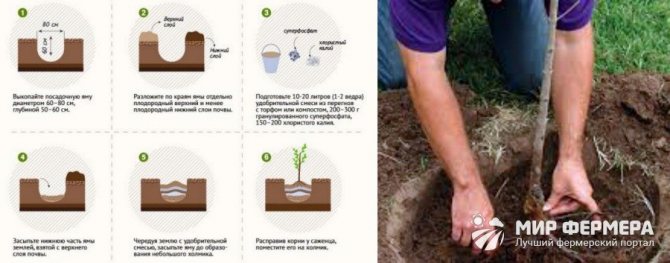

Figure 1. Rules for planting seedlings
After planting the tree, it is necessary to form a watering circle. To do this, around the entire circumference of the hole, a mound is made in the form of a roller with a height of 5-7 cm, and the trunk circle itself is mulched with organic matter (rotted manure, straw, raw compost). The planted tree must be watered abundantly and tied to a peg.
Features of the
When planning to lay a garden, you should start by cultivating the soil in the selected area: deep loosening of the soil and removing weeds, because in loose soil, seedlings grow quickly and begin to bear fruit much earlier. Then you need to decide on the size of the holes.
Note: For annual plants, holes are dug with a depth and width of 50-60 cm, for two-year-olds, a hole 110-120 cm wide and 60-70 cm deep will be needed.If the soil is heavy, then 15-20 cm are added to all sizes.
If the soil has an increased acidity level, it must be calcified. For fertilization, organic and ash fertilizers are used. It is not recommended to use fresh or half-rotted manure, because if there is a lack of air in the soil, it decomposes and releases harmful substances that poison the entire plant.
Where to plant fruit trees on the site
When choosing a place for fruit crops, they pay attention to the relief, the nature of the soil, the depth of the groundwater, the possibility of protection from the wind. At your summer cottage, give preference to a place with good illumination, which is not flooded by groundwater. So, the maximum height of standing groundwater for apple and pear is 1.5 m, for cherry and plum - 1 m.If the groundwater is high, drainage will have to be done (Figure 2).
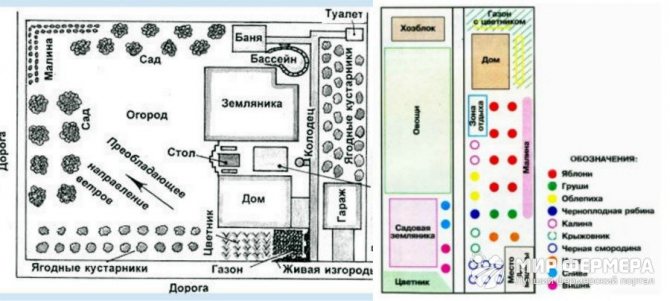

Figure 2. Placement of fruit trees and shrubs on the site
It is known that gardens grow best on gentle slopes, but flat laying is not so effective. It is not recommended to lay a garden in hollows due to stagnation of cold air and excess water in them.
From which side of the world to plant fruit trees
An important role is played not only by the fact when to plant seedlings of fruit trees in spring or autumn, but also the side of the world where the garden will be located.
Experienced gardeners advise planting fruit trees on the south, south-east and south-west side of the site.
Landing types
The correct arrangement of plants in the garden, that is, the type of planting, most directly affects the survival rate of seedlings. Therefore, it is so important to imagine it in every detail before you start laying a garden. It is also necessary to calculate the distance between seedlings. The interval between them should be no less than the height of mature trees. It is in such conditions that plants will be more efficiently pollinated and bear fruit. It is also known that more fruit is formed on the side branches, so the crowns of fruit trees should be shaped so that they grow wide (Figure 3).
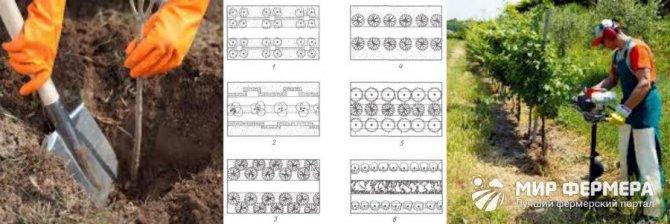

Figure 3. The main types of planting of fruit trees: 1 - in groups, 2 - central arrangement with bouquets, 3 - checkerboard, 4 - row planting, 5 - row planting of different species, 6 - central planting of shrubs
However, you should be aware that in a too sparse arrangement, fruit trees are more susceptible to sunburn and frostbite, therefore they grow much worse. In this case, so-called "seals" are planted between tall fruit crops, that is, undersized fruit crops, for example, cherries or plums. They are not as durable as apple and pear trees, and therefore stop fruiting after 20 years of life and can be removed, since the crowns of tall trees by that time have already had time to fully form and grow.
Is it possible to water trees using the sprinkler method
Sprinkling can be used for seedlings and young trees during hot dry summers. However, you need to remember that this should be done in cloudy weather, and preferably in the evening at sunset or after sunset. If you use post-feeding during the day, the water droplets will focus the sunlight and the leaves will get burned.
Sprinkling of adult fruit-bearing trees is carried out as a preventive measure before possible recurrent frosts. This treatment increases the resistance of the leafy crown to sudden changes in temperature. In this case, sprinkling is carried out throughout the night and ends before dawn.
How to save a seedling if planting late
The first frosts are about to occur, and a suitable seedling has been purchased, but not planted. Planting will have to be postponed until spring. The situation is not uncommon.
- To save the planting material, you need:
- Dig a trench as long as a sapling, 10-15 cm deep on the south side, up to 40 cm from the north.
- Cover the bottom with a layer of fallen leaves.
- Wrap the apple tree in a non-woven fabric.
- Place the tree with its roots in the deepest part, with the crown towards the south. Leave the tips of the shoots above the ground.
- Fill up the trench with earth and peat.
- Pour a thick layer of fallen leaves, sawdust on top, cover with spruce branches.
- As soon as the snow melts, the ground begins to thaw, the seedlings are taken out and prepared for planting.
If the winters in the region are very harsh, the trench is made deeper.
Distance to the border when planting fruit trees
When planting fruit trees on your site, it will be useful to familiarize yourself with the legislative acts of tree planting in order to maintain good neighborly relations. So, the norms stipulate that the distance from a perennial plant to the border of the site should be at least 3 meters for low trees.
The larger the diameter of the crown, the greater this distance becomes, because the branches and roots of a tree that extend beyond your site, neighbors can rightfully remove without your consent. Bushes can be planted at a distance of 1 meter from the border, and plums, peaches, cherries - 2 meters.

